September 3, 2018 - USS New Jersey (BB-62) & USS Olympia in Philadelphia
|
|
Today was Labor Day, a Monday, and a company holiday, so I was looking for something to do. I've been wanting to go tour a Battleship for years, and I knew there was one in Philadelphia, so I asked Lynnette if she wanted to drive up to Philly and see a Battleship. Sure!
It was an easy and pleasant drive up there, no traffic. The Battleship New Jersey is actually tied up across the river from Philadelphia, in Camden, New Jersey.
I remember watching a 60 Minutes segment on Camden back when I was a teenager and knew from that Camden had issues. But I wasn't prepared for what I saw when driving through Camden to the Battleship. It was like driving through an empty, abandoned town. I've never seen anything like it in this country.
|
| |
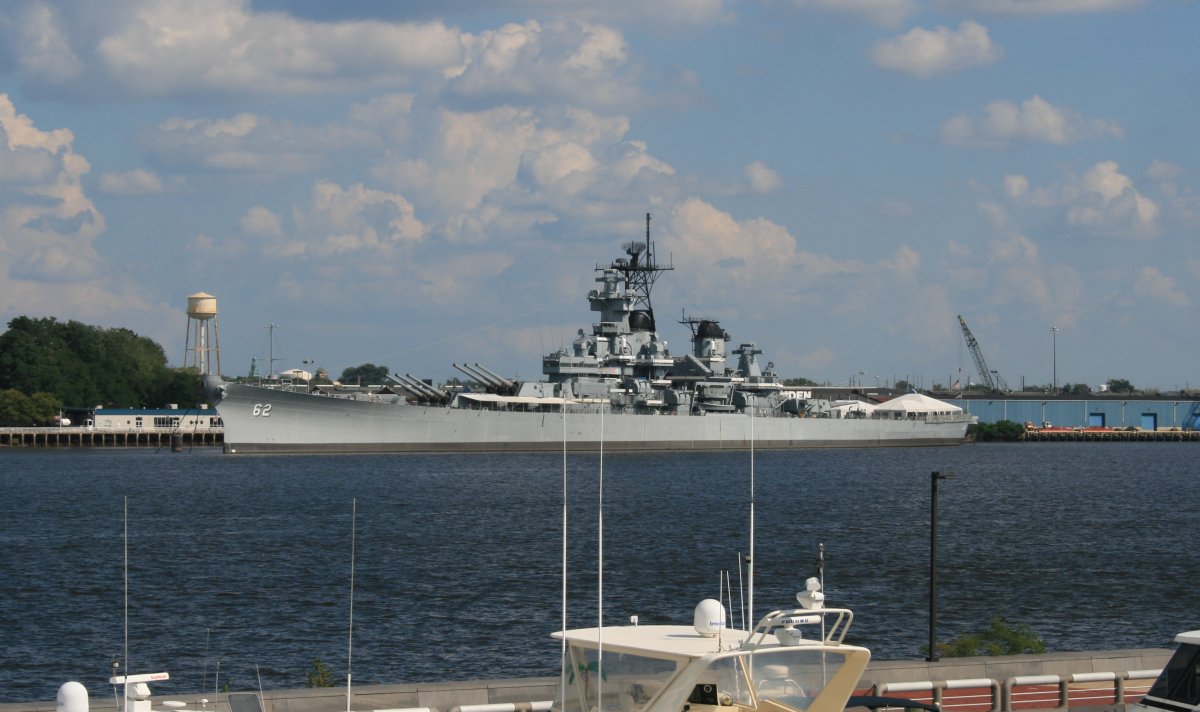 |
|
|
Since today as a national holiday, I didn't know how crowded it would be. I needn't had worried. We got there right when it opened, and got practically the closest parking lot to the ship.
Here Lynnette is standing by a spare 16-inch gun barrel located near the entrance.
|
| |
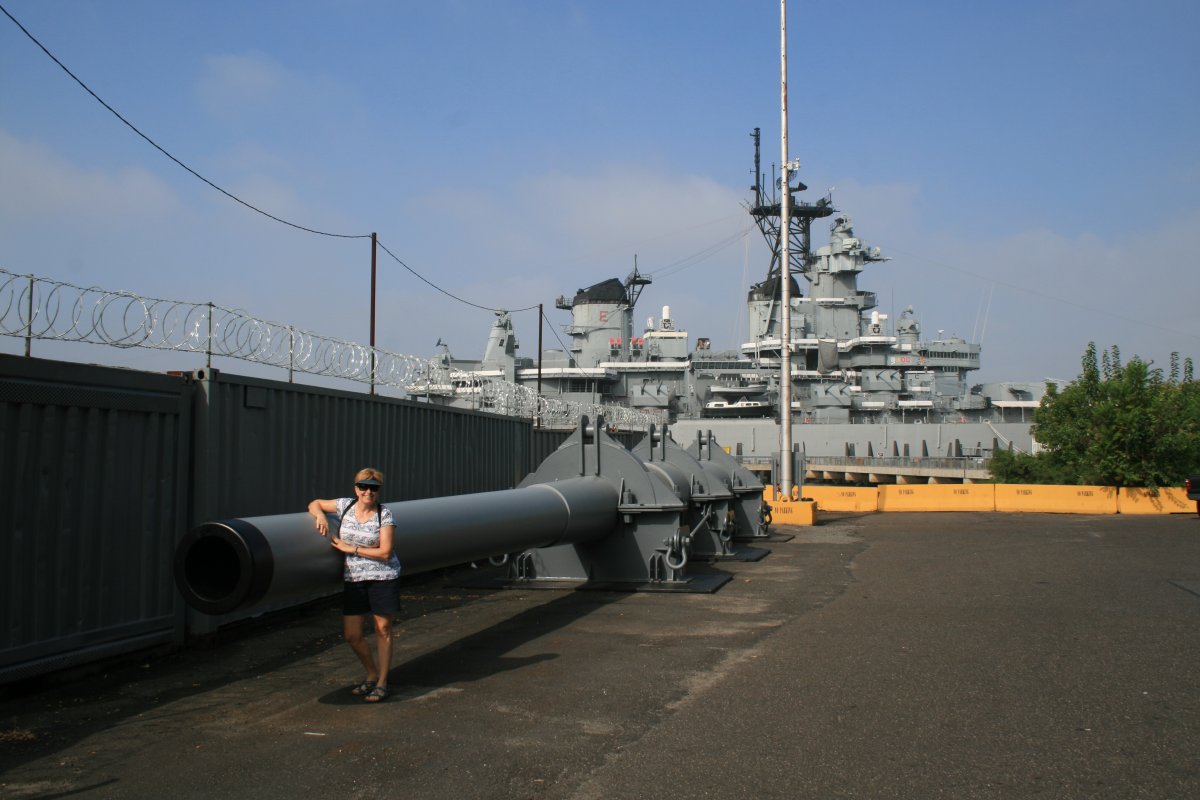 |
|
| Looking down the business end. Notice the spiral "rifling" which makes the shell spin as it leaves the barrell. The spin makes it go straight. |
| |
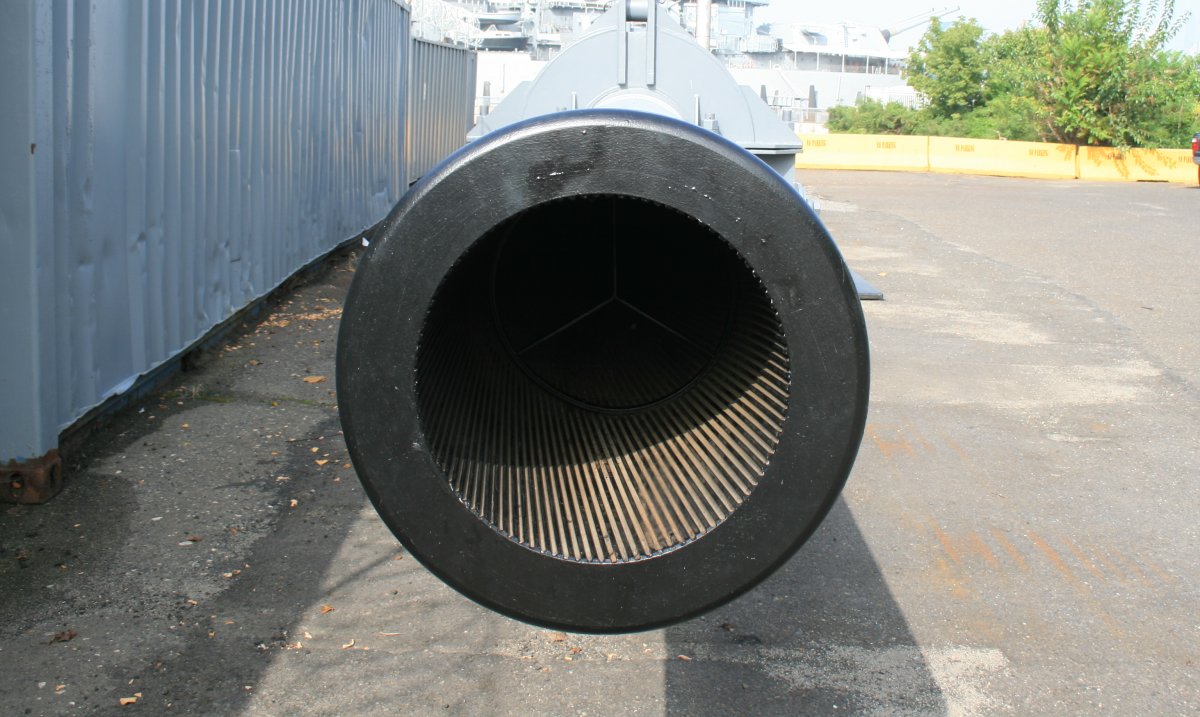 |
|
|
Yours truly outside the ticket office.
BB-62 USS New Jersey is one of four Iowa-class battleships, the last battleships commissioned in the U.S. Navy. The other three were USS Iowa (BB-61) (now in Long Beach, CA) , the USS Missouri (BB-63) (now at Pearl Harbor) and the USS Wisconsin (BB-64) (now at Norfolk, VA). |
| |
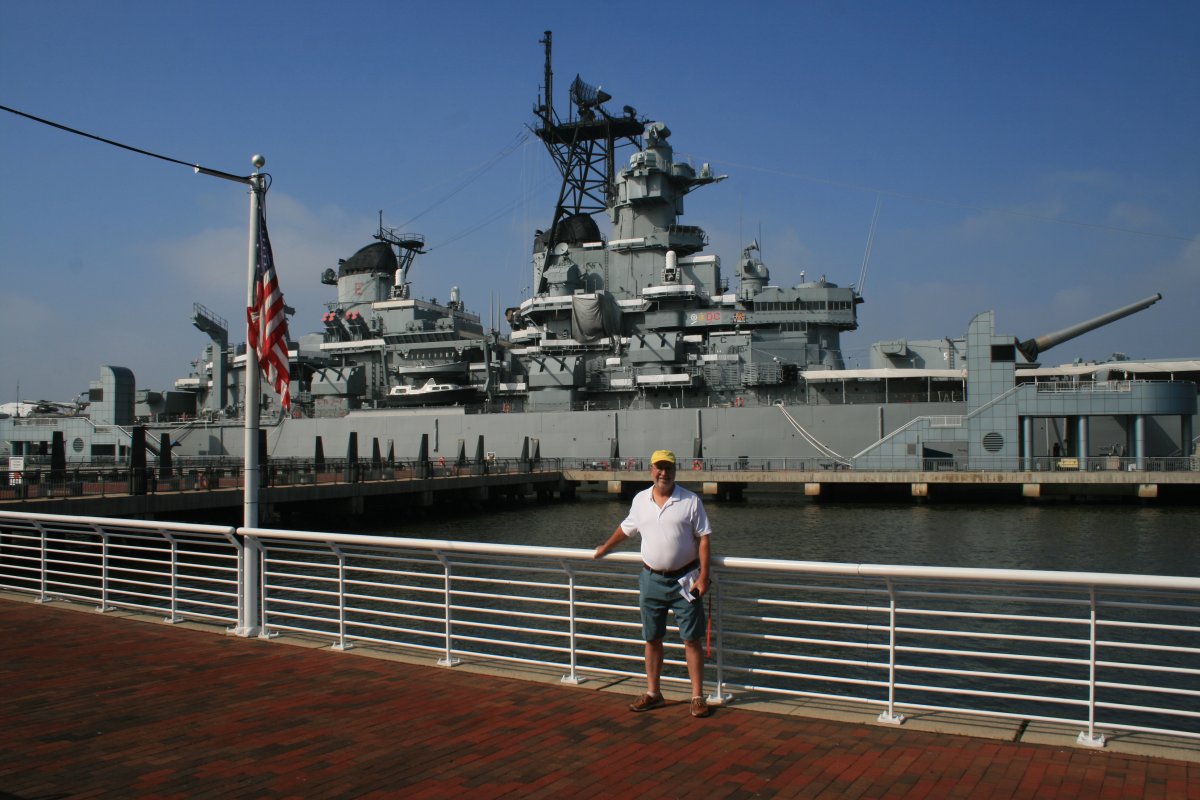 |
|
|
About to board the great ship.
USS New Jersey was built just across the river at the Philadelphia Navy Yard in a little over two years to build her.
All ten of the U.S. Navy's modern fast battleships that fought in WWII had been building for at least ten months when Pearl Harbor was attacked on December 7, 1941: the North Carolina class (2), the South Dakota class (4) and the Iowa class (4). USS New Jersey was laid down on September 16, 2940 and launched December 7, 1942.
|
| |
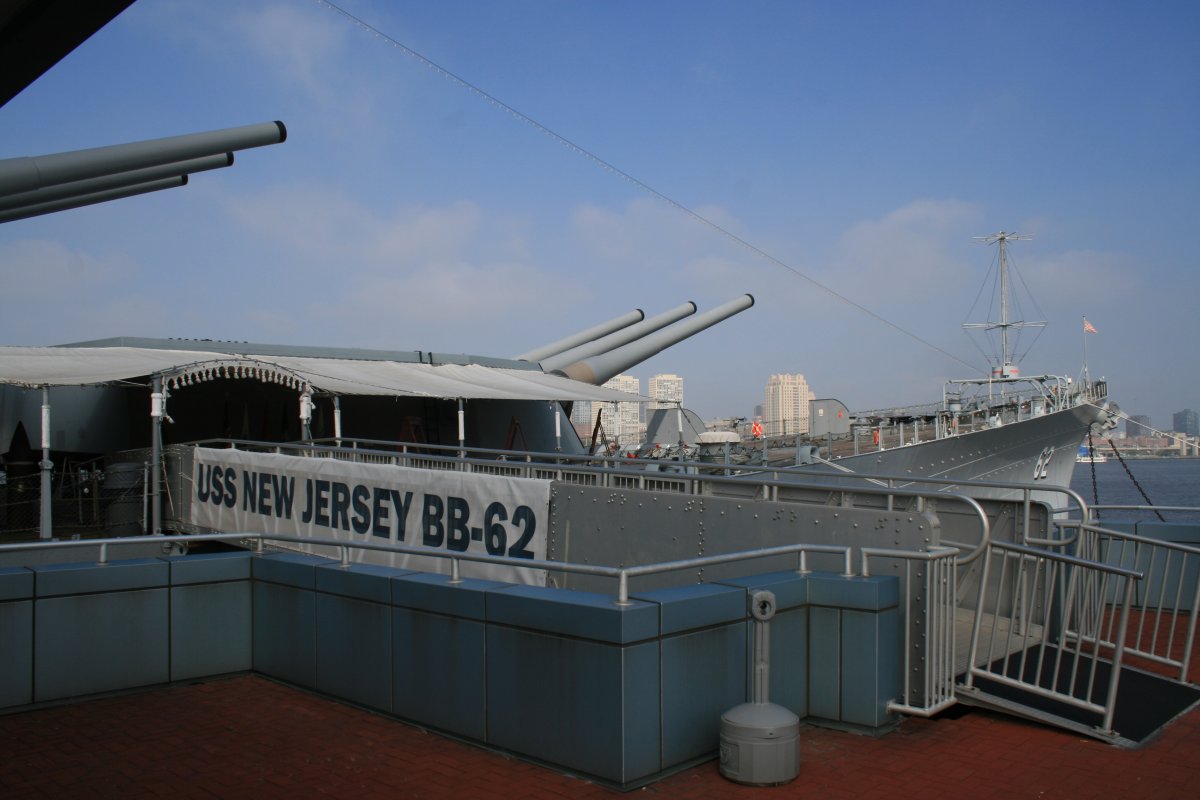 |
|
|
The forward turret, which its massive three 16-inch guns.
USS New Jersey fought in WWII where she was Admiral Halsey's flagship, Korea, one deployment in Vietnam, and in the 80s.
|
| |
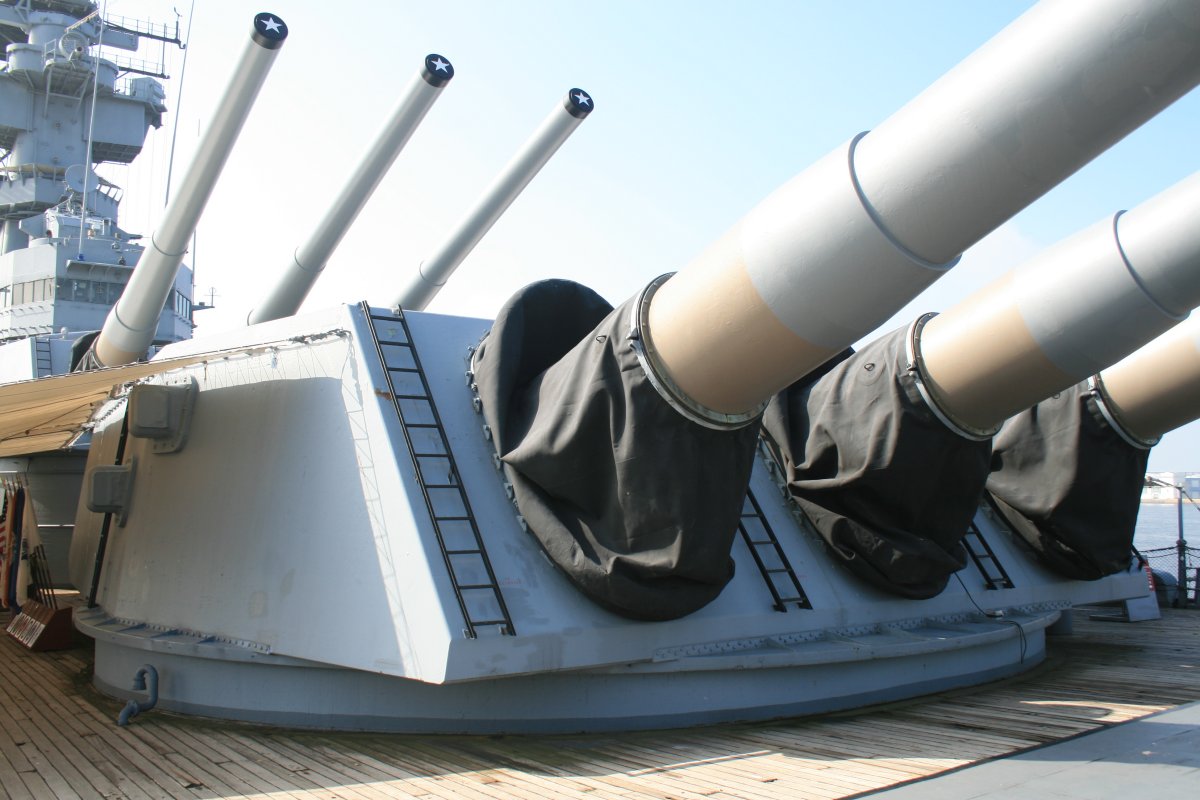 |
|
|
Battleship decks were covered with teak wood planks. This was because steel decks were too slippery (they didn't have non-skid back in WWII), could cause static discharge, and got to hot.
But wood doesn't last forever, and as you can see, the teak is not in very good shape here. They do intend to replace it; however, it is hideously expensive. I think the docent said one 3" by 8 foot plank costs $100 or so. Do the math.
I think 40mm and 20mm antiaircraft guns used to be mounted here.
|
| |
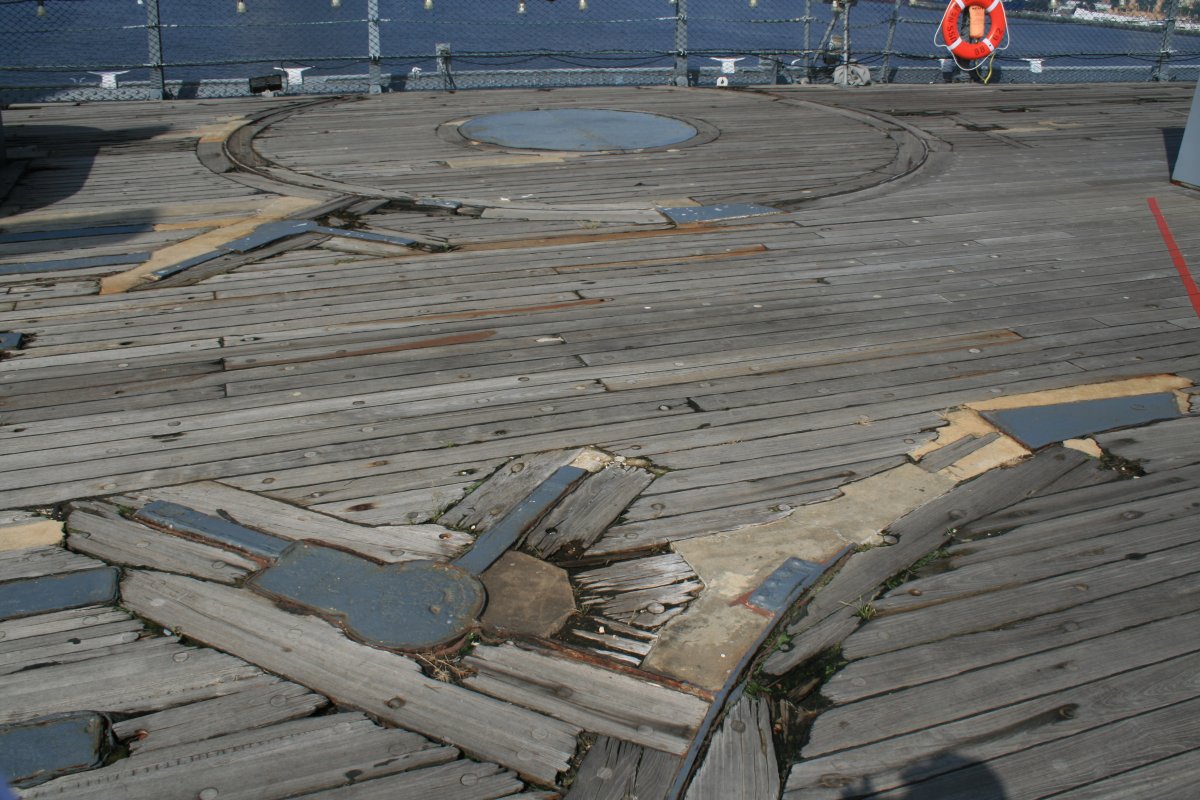 |
|
|
Manning the M2 Browning machine gun.
|
| |
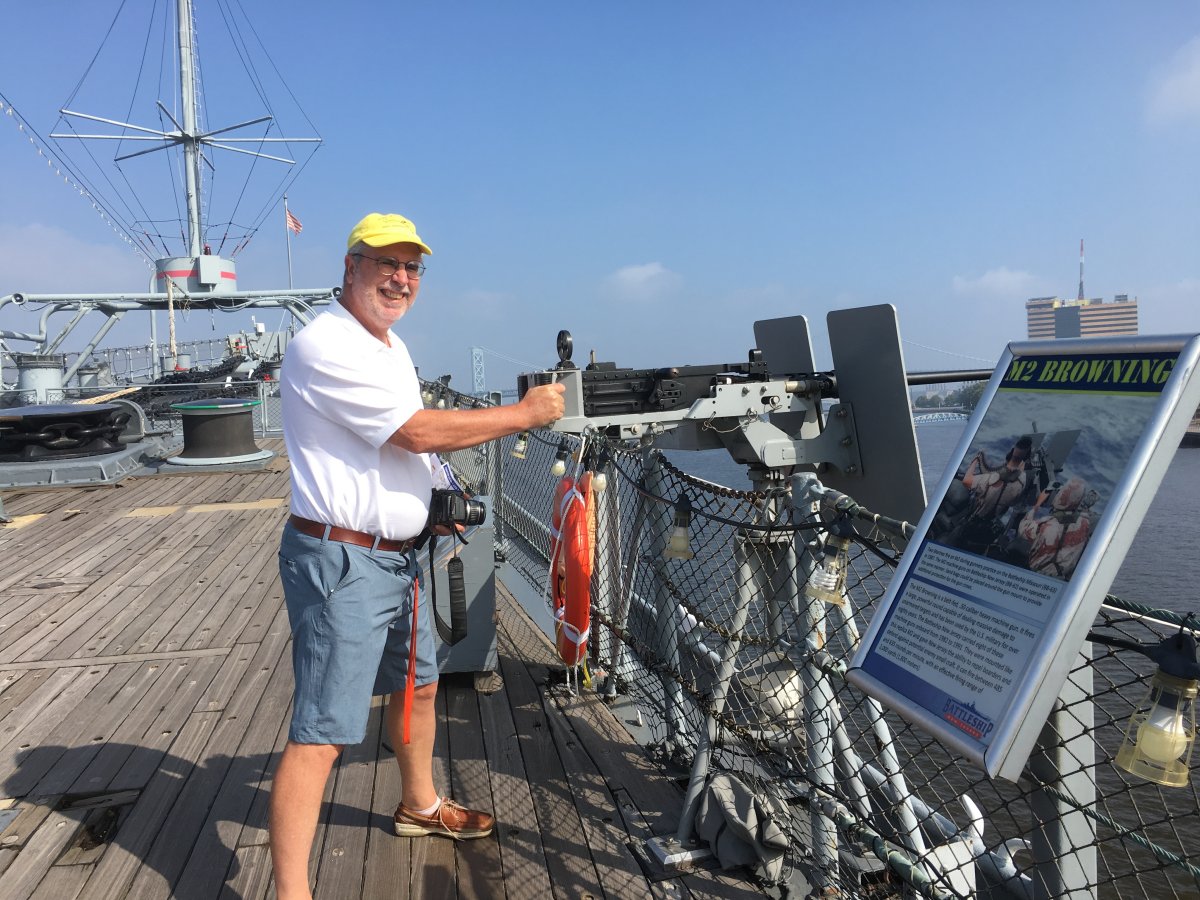 |
|
| That's one big chain! |
| |
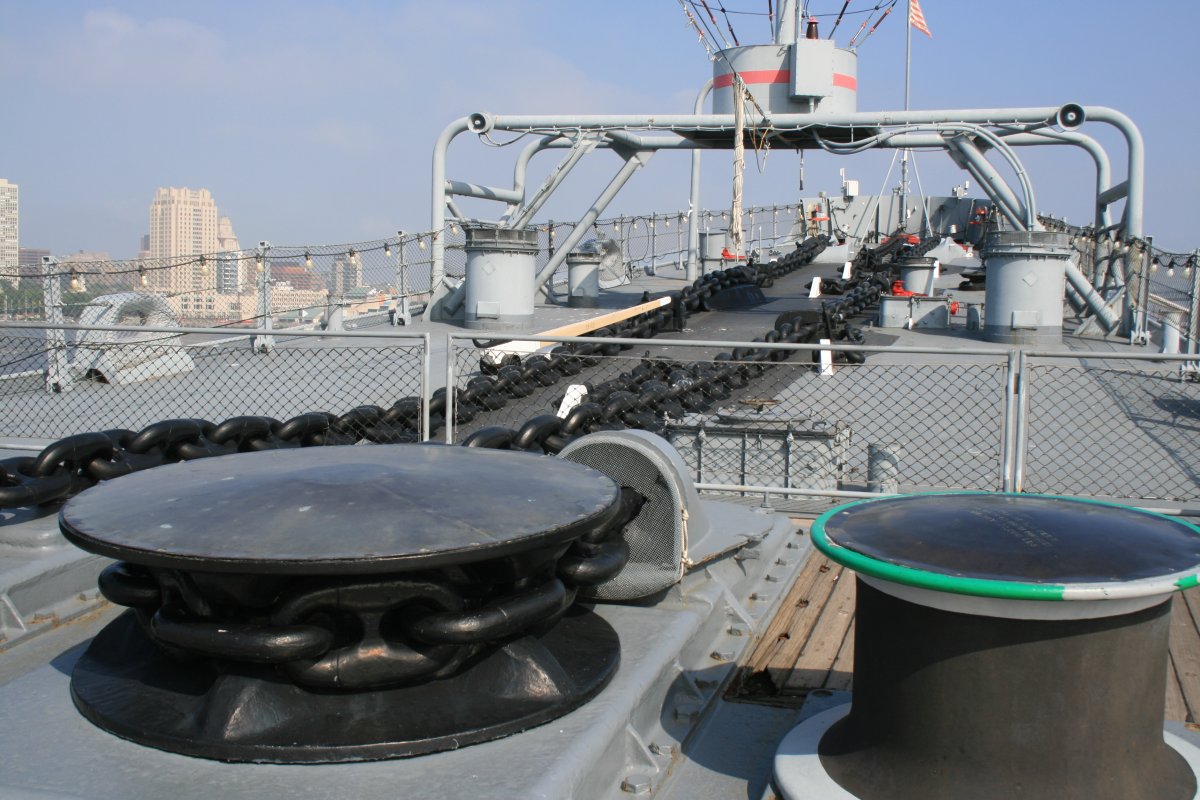 |
|
|
Looking aft from the bow
|
| |
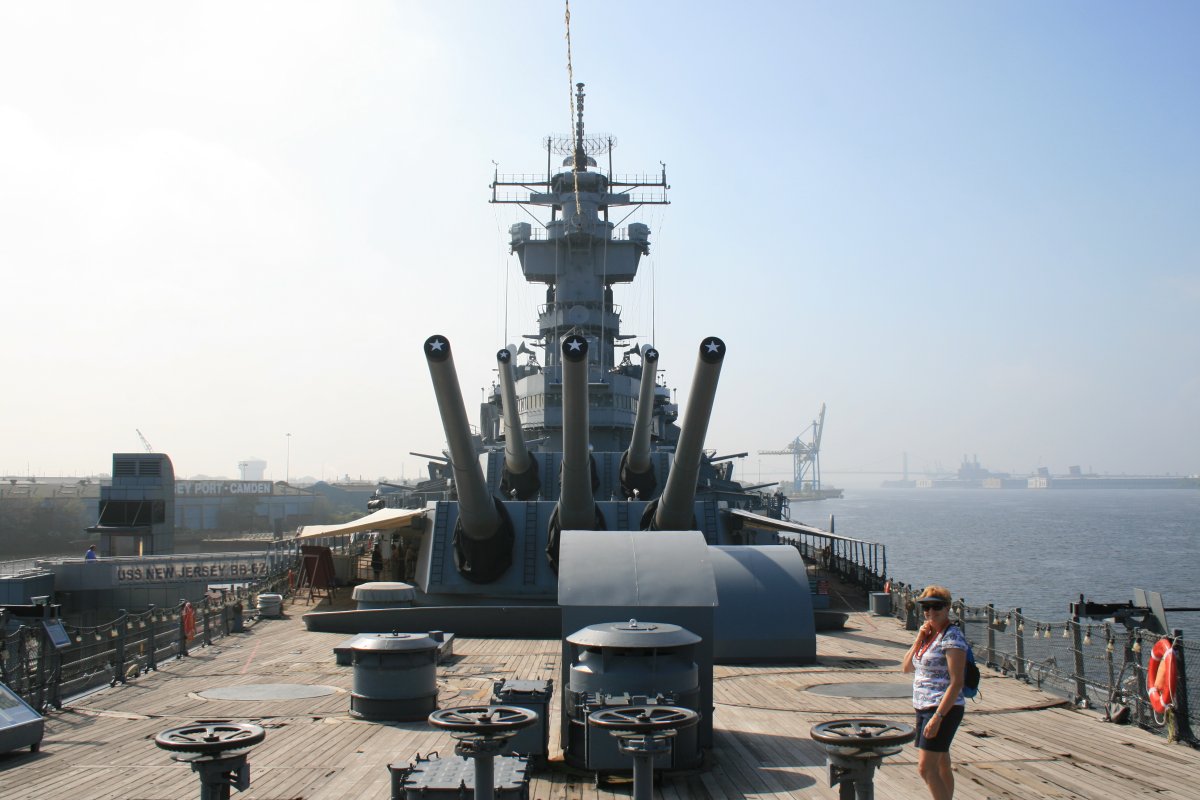 |
|
| Lynnette getting some rack time. |
| |
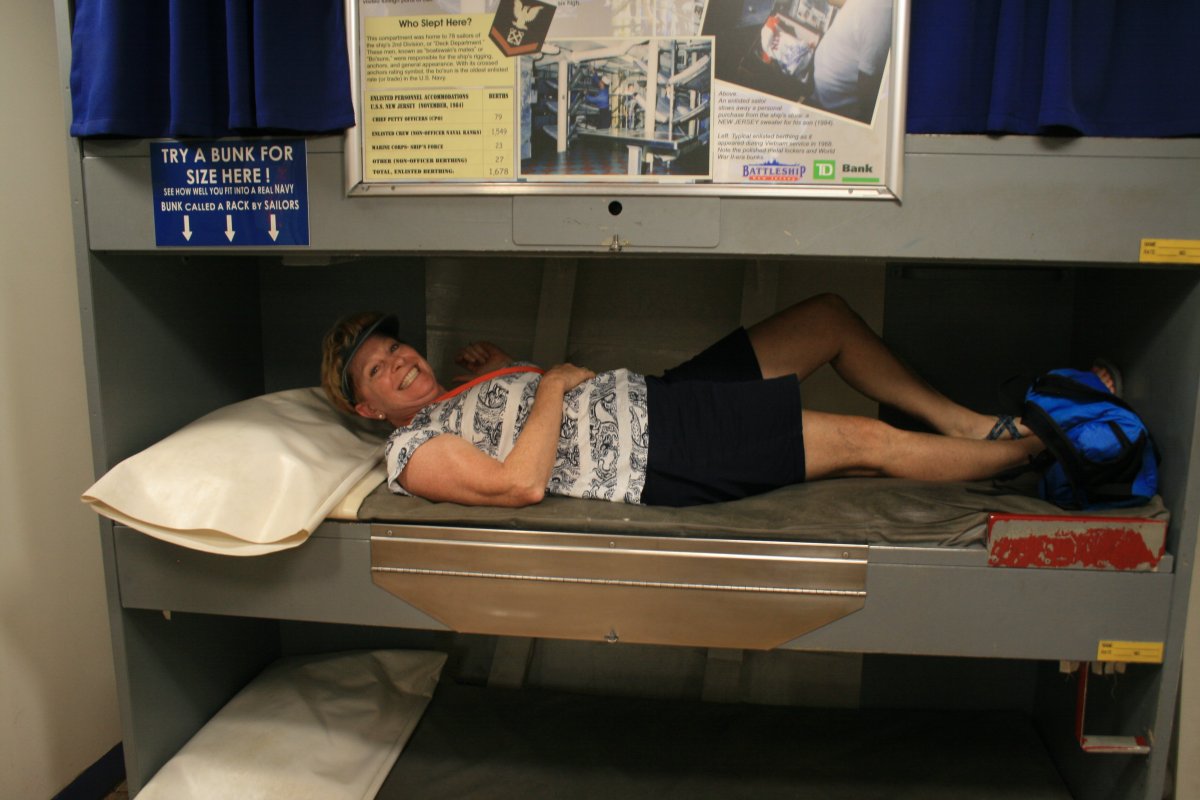 |
|
| A painting of the New Jersey plowing through heavy seas. |
| |
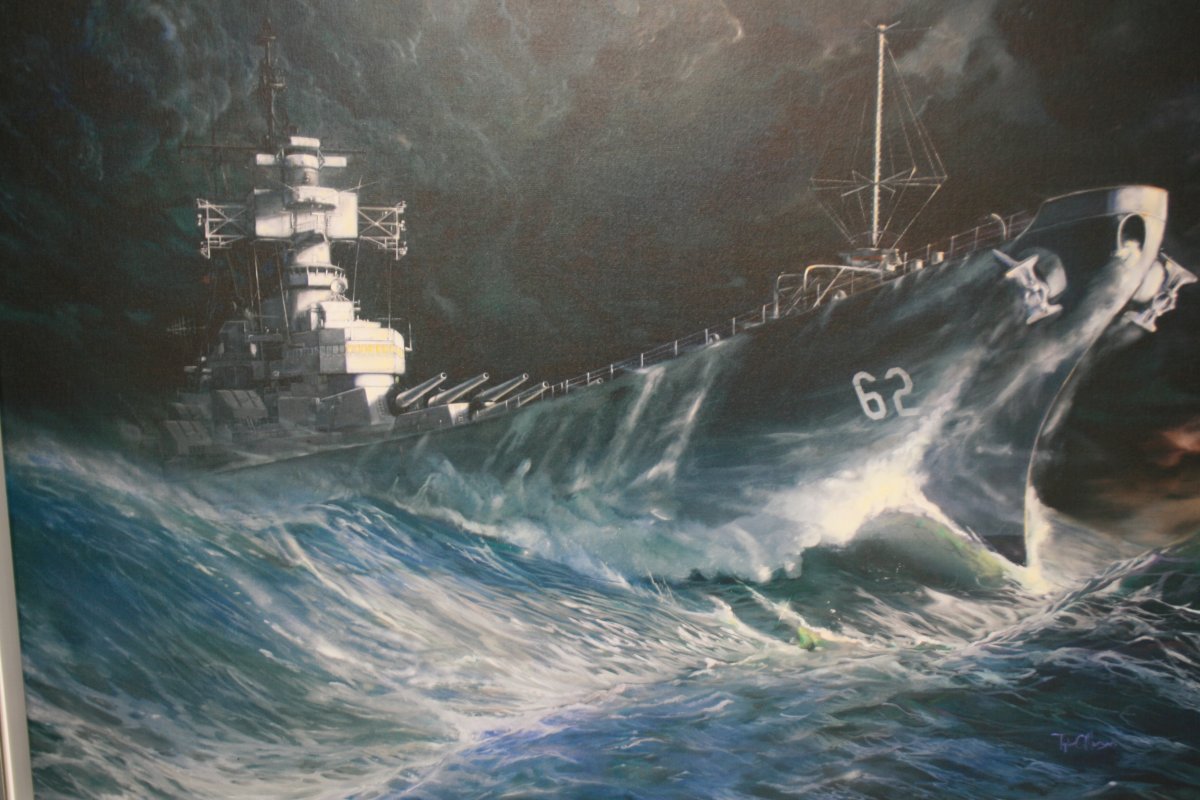 |
|
|
We went on the standard self-guided tour with audio-devices through the ship. This was excellent and of course recommended. But we also paid extra for a 1 1/2 hour guided-tour of one of the turrets.
Here is our guide Louis talking to us outside the #2 turret alongside a 16-inch shell and a powder bag replica. It would take four to six powder bags to fire a shell. The shells, depending upon what type, weighed between 1,200 and 1,600 pounds.
|
| |
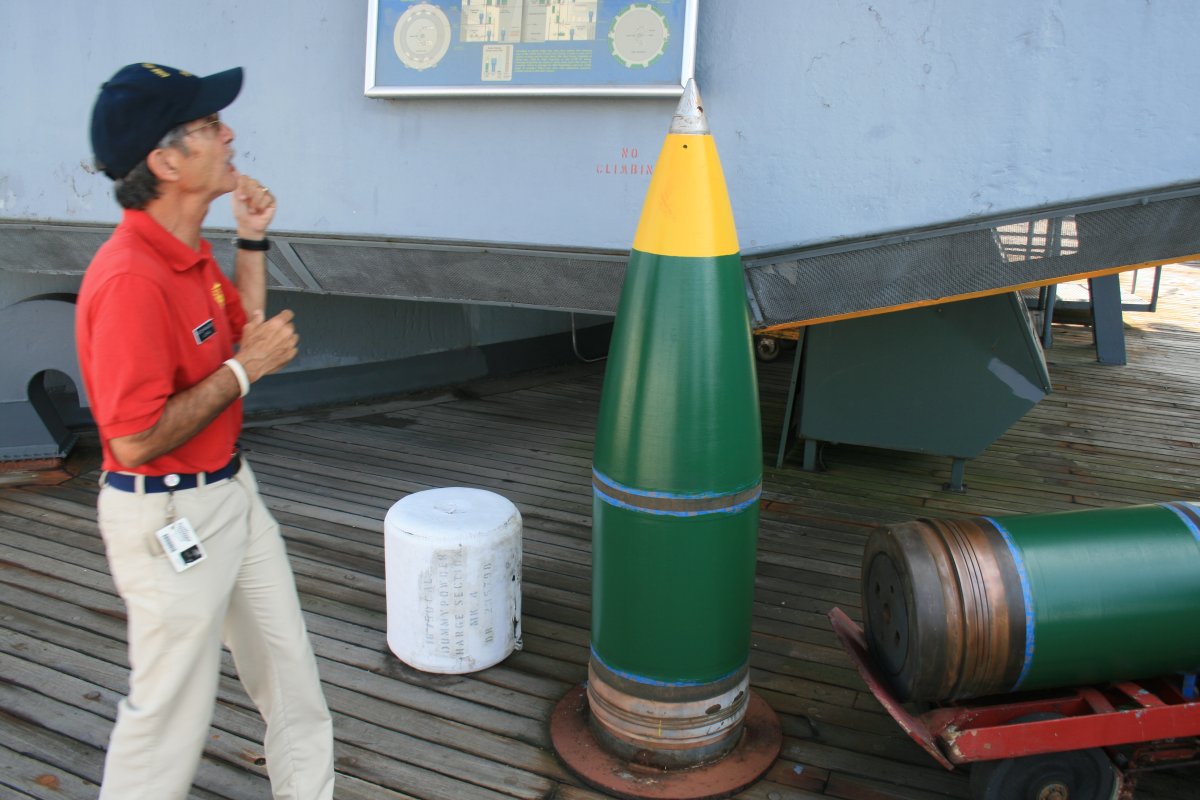 |
|
|
Now we are inside the #2 turret. That big cylinder on the right is runs athwartships and is actually an optical telescope, used to acquire targeting information on the targets.
As our guide explained to us, in cast of battle damage, the ship had an incredible amount of redundancy to be able to fire her guns.
|
| |
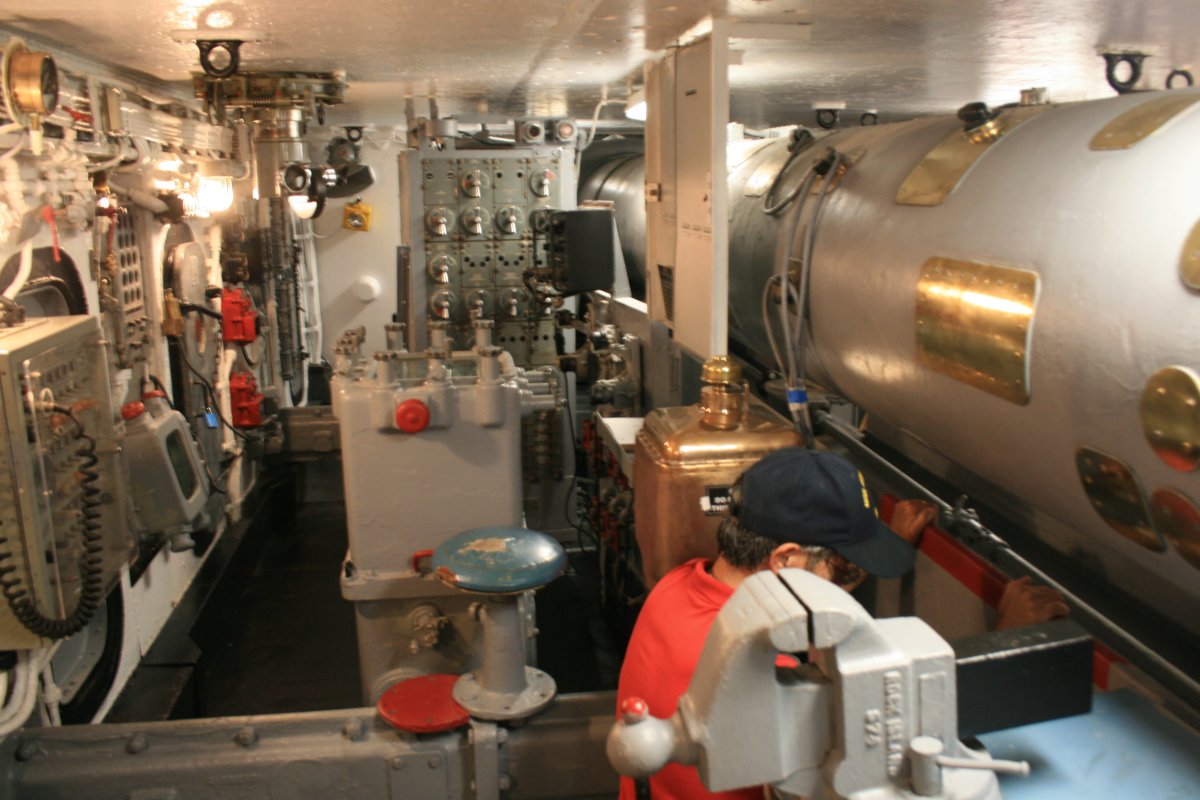 |
|
| You can't just pick up a 1,600 pound shell and carry it from storage to placing it in the gun barrell. Down under the turret, we saw the machinery, elevators, and chain hoists to move the shells from the magazine up to the gun barrells. |
| |
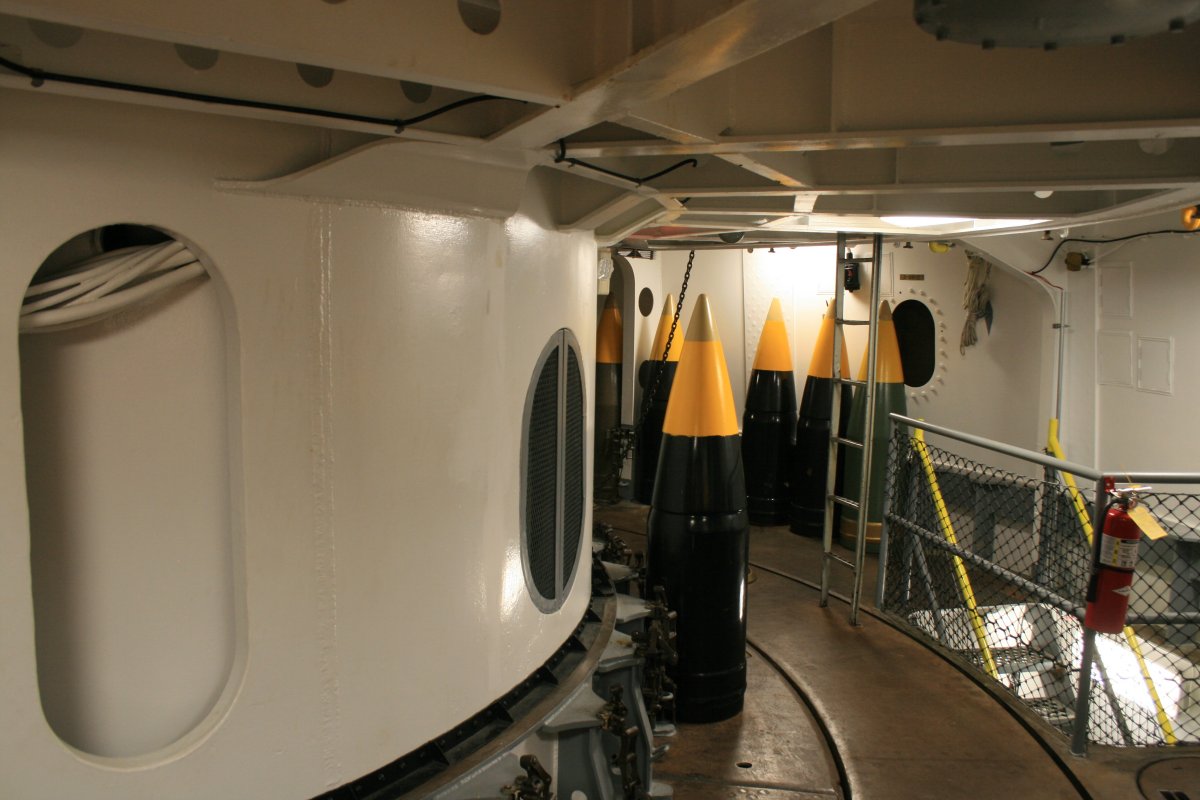 |
|
| The shells were pre-positioned around the outside of the turret column. Notice the machinery below to move the powerbags around. |
| |
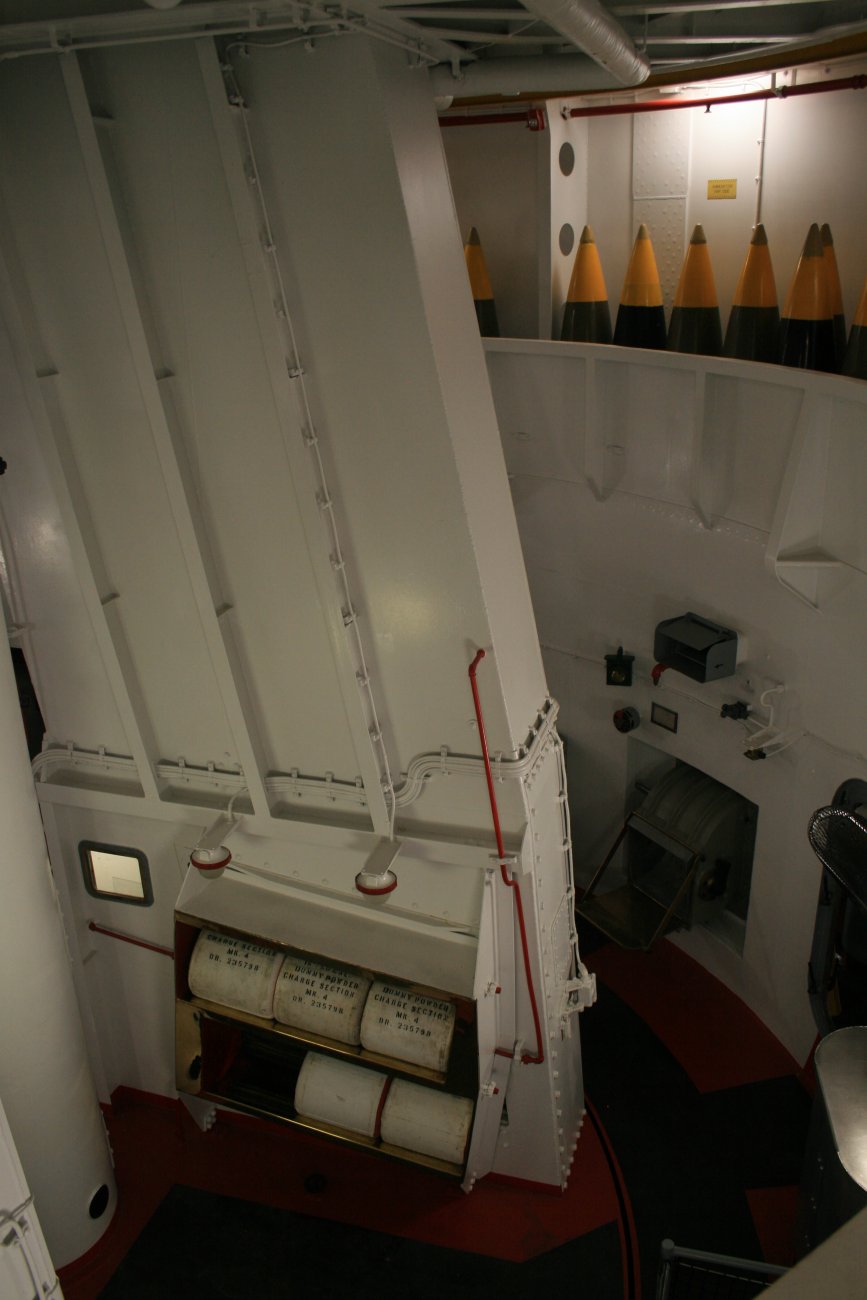 |
|
| |
| The powder magazine. Each powderbag had to be removed from the grey storage cylinder on the right -- it held three -- and placed on the brass tray. The powder bags weighted "only" sixty pounds and could be picked up and moved by a man. |
| |
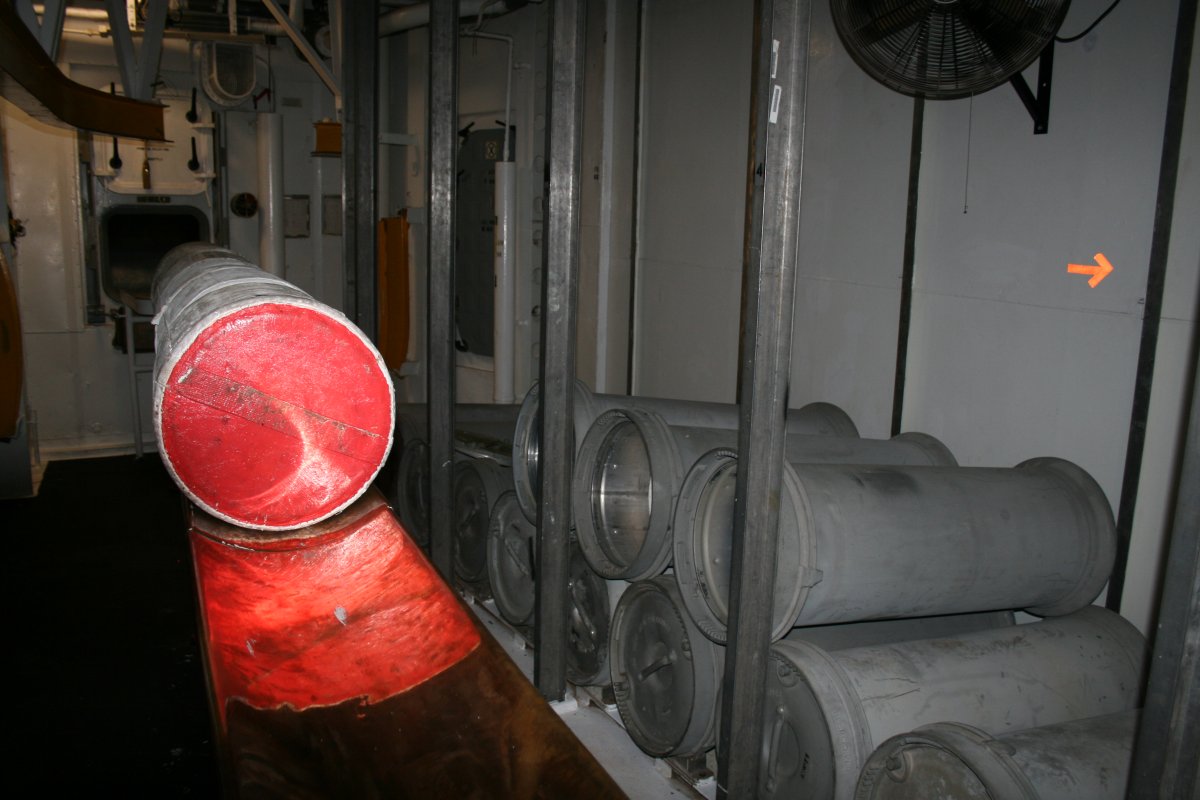 |
|
|
The fire-control computer. It ran on electricity, if you had it, and if not, by turning knobs mounted on the side. You entered in all the inputs: range, bearing, wind speed, temperature, etc. and the computer figures out the elevation and azimuth of the guns. Of course, you could use radar data, or the optical data from the huge telescope. Since the guns could fire the lighter shells 27 miles, they also had to take the curvature of the earth into account! All in all, it was a very complicated problem, but they figured out how to do it, and the guns were very accurage.
|
| |
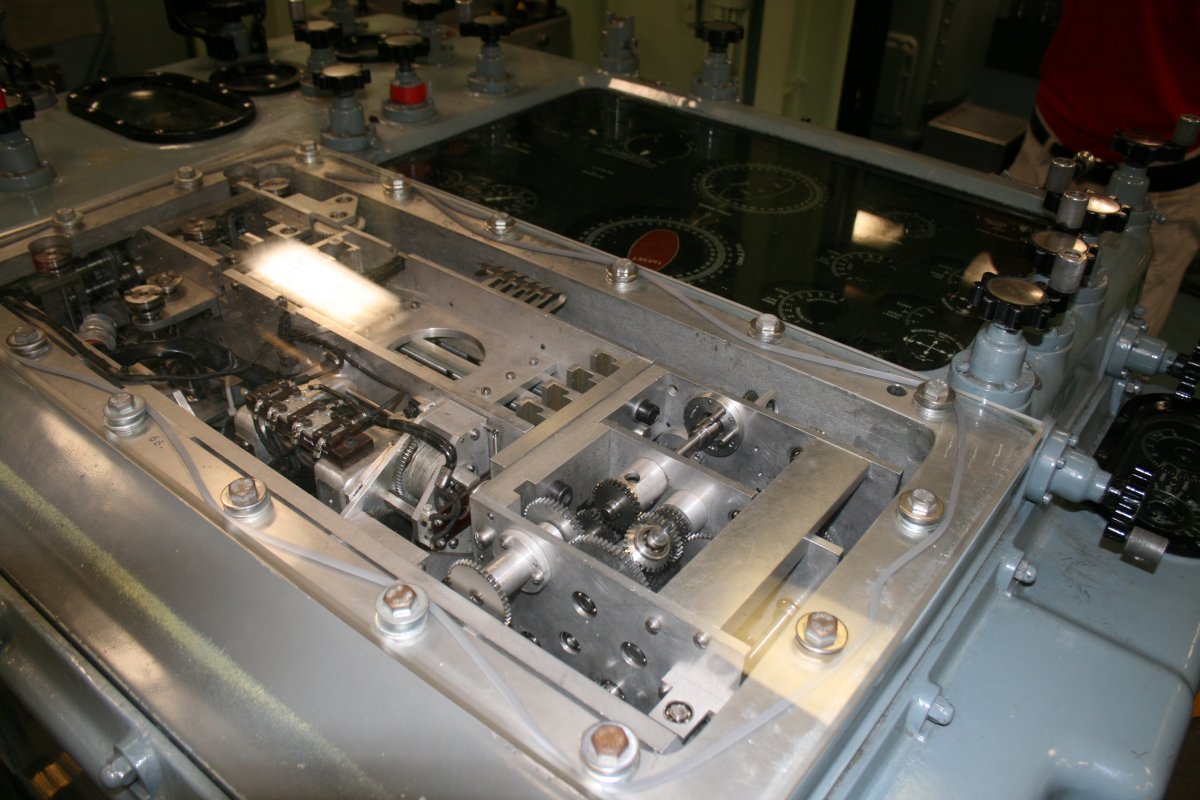 |
|
| Each of us got to fire the guns! |
| |
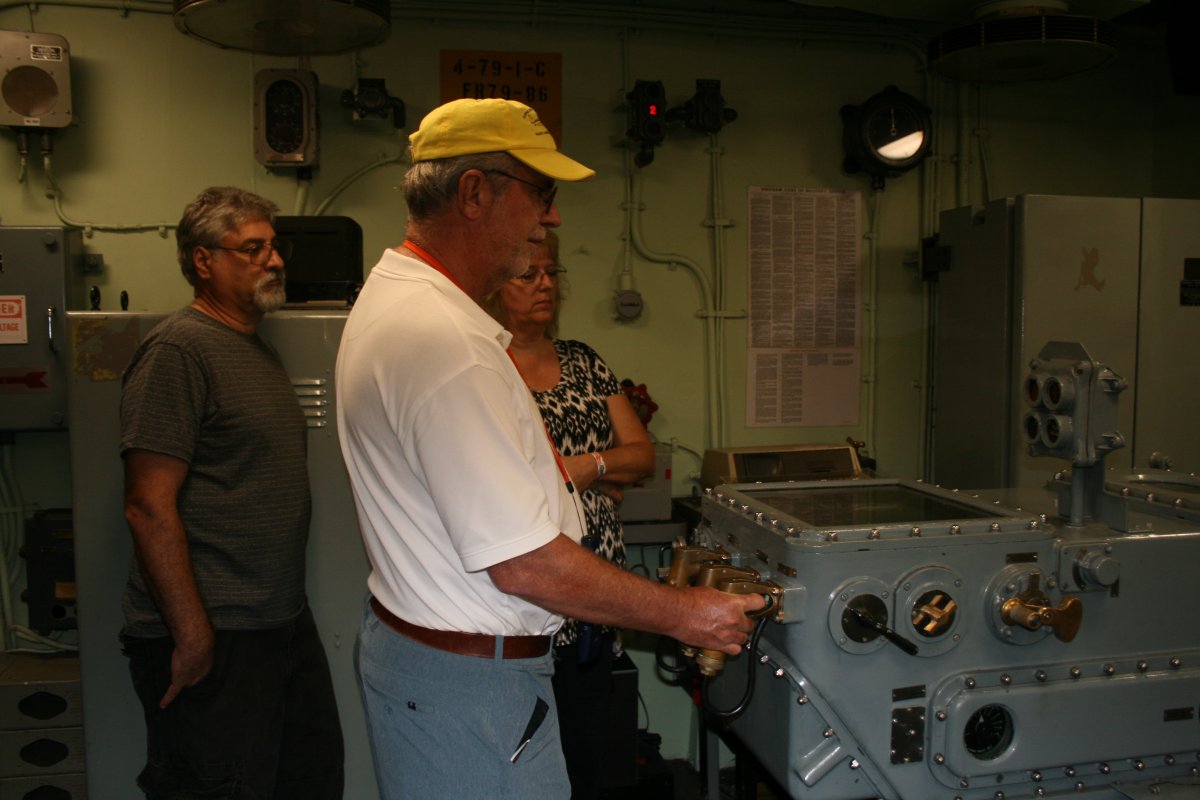 |
|
|
Fire!
|
| |
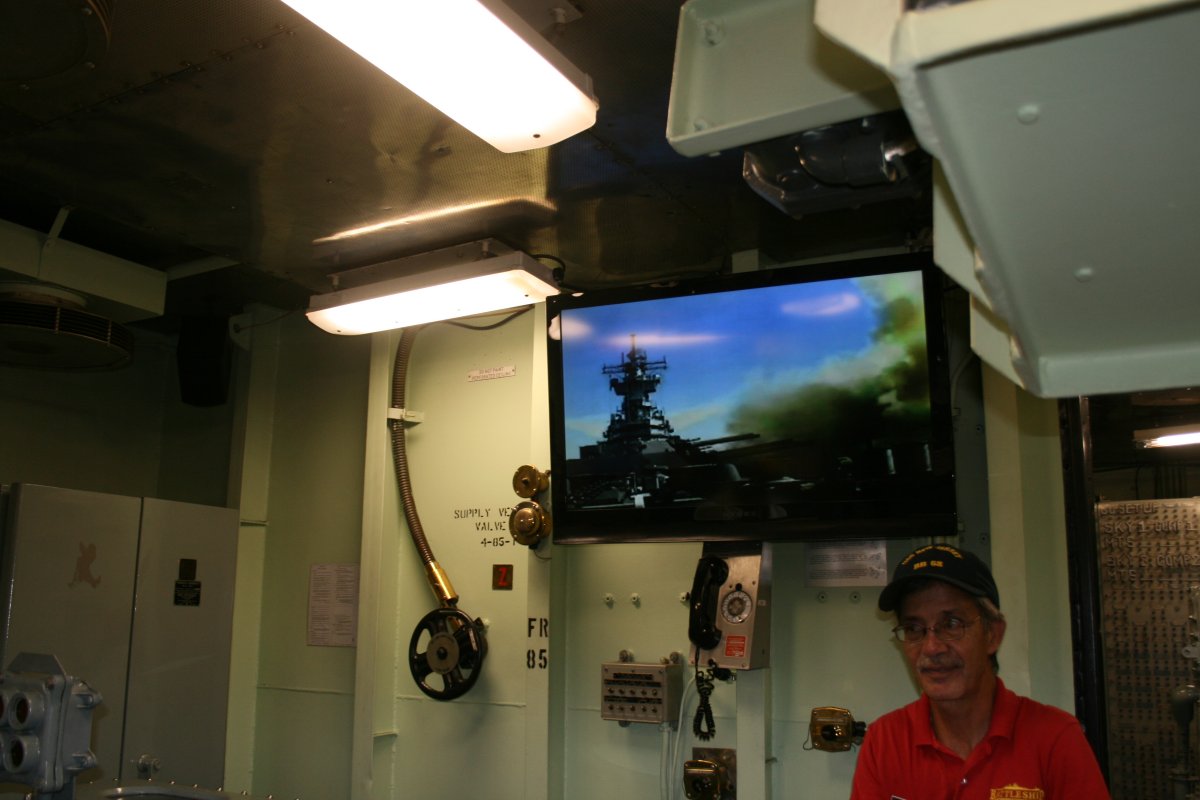 |
|
| Pulling the triggers on the side of that console fired the gun. I'm sure there were other places on the ship where you could fire the guns as well. |
| |
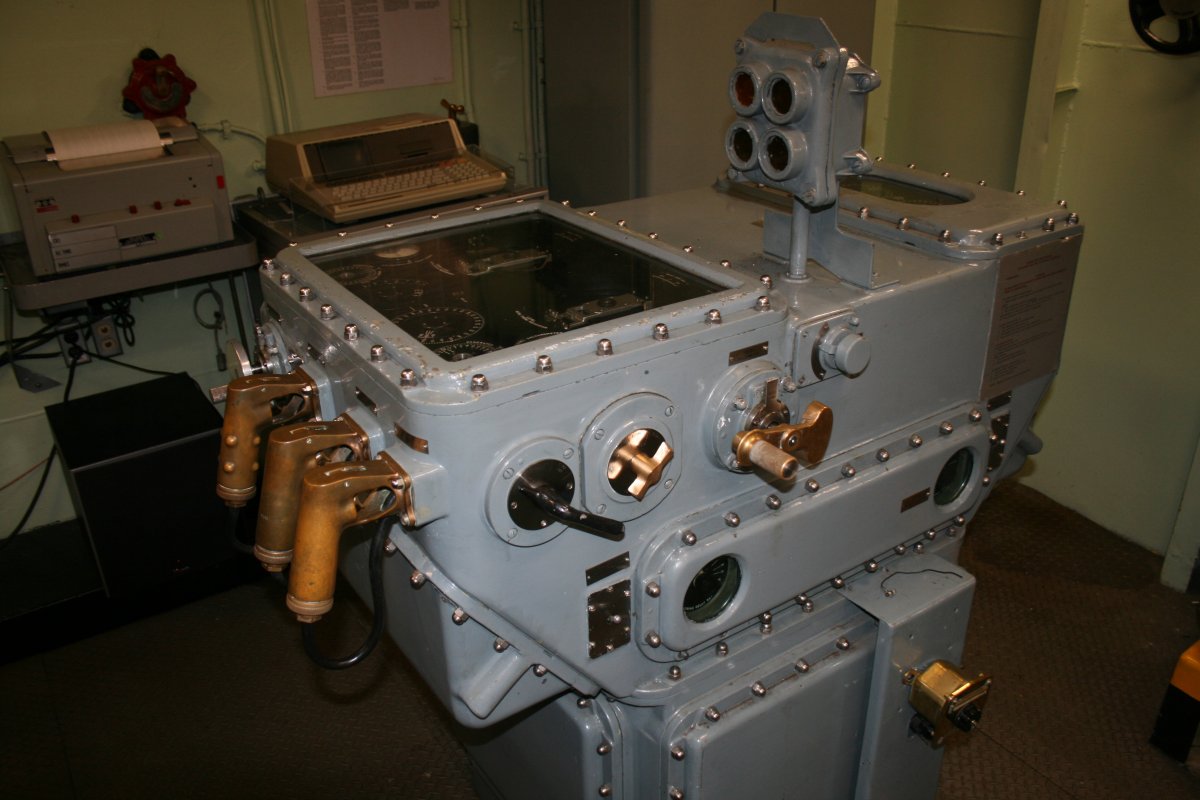 |
|
|
Broadway, the passageway that runs the length of the ship.
The guided tour was outstanding; I would highly recommend it. Louis really knew his stuff, and answered virtually every question we had.
|
| |
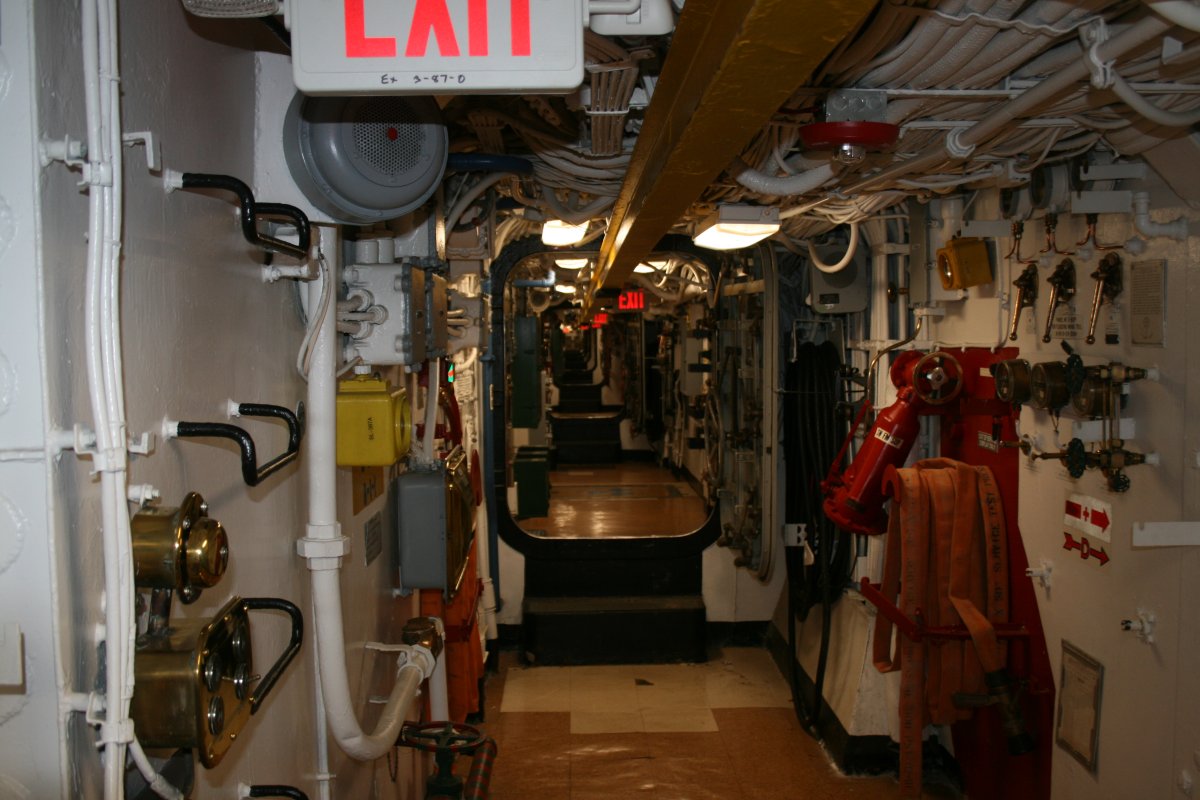 |
|
| After the guided tour, we resumed the self-guided tour. Here we are on the bridge, looking at the Captain's Chair. They sould take the windows out before battle. |
| |
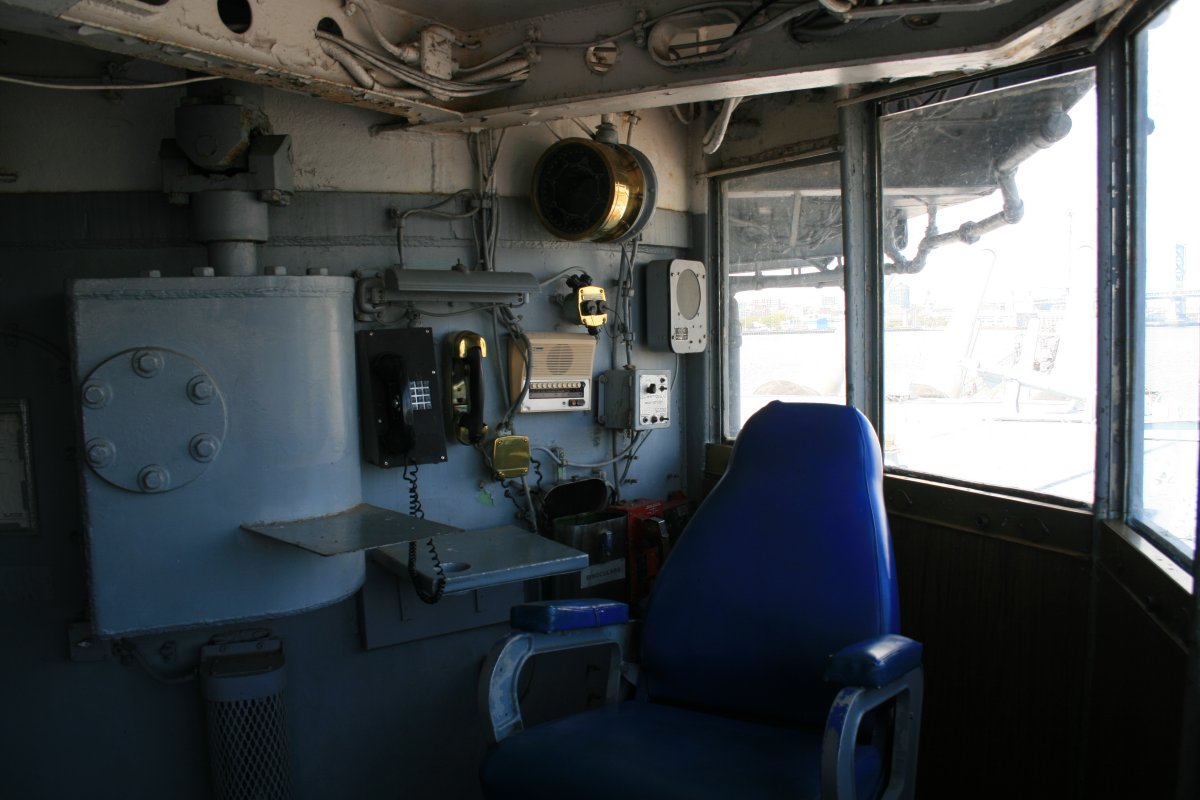 |
|
| The Captain had a nice view. |
| |
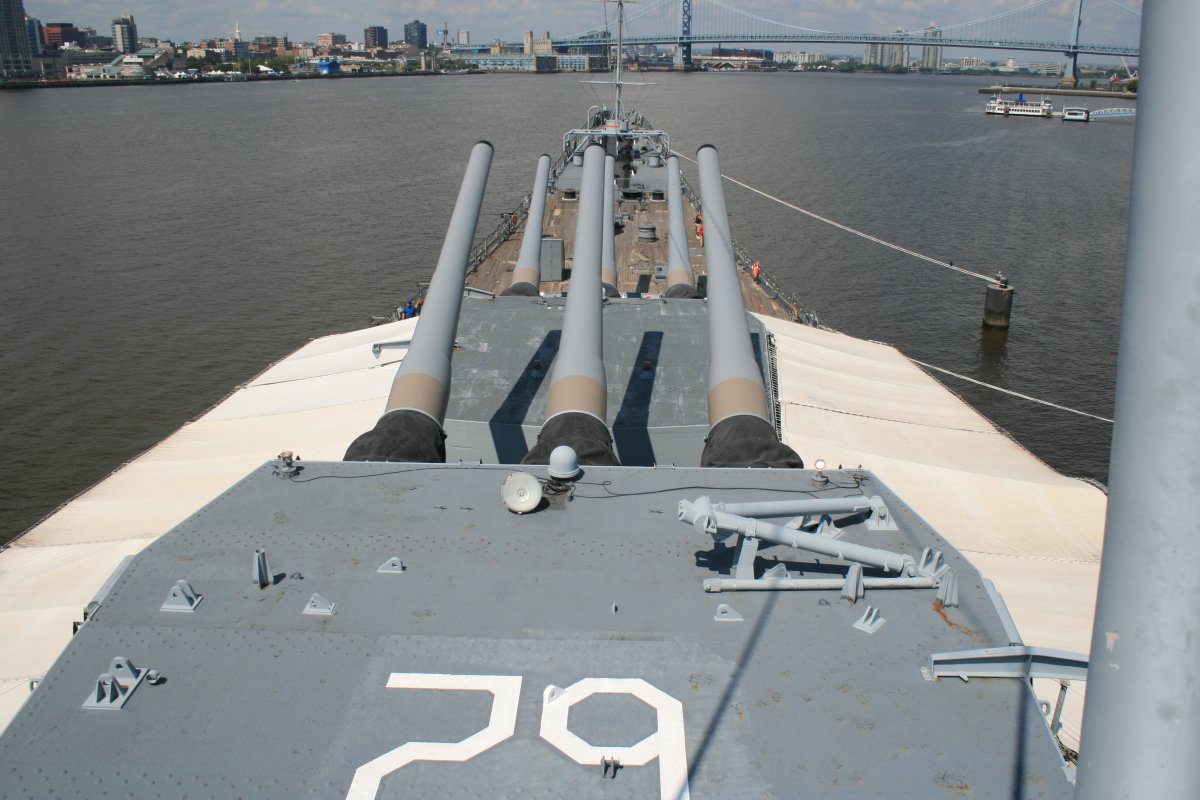 |
|
| This is the area where driving the ship took place. Where are the windows, you ask? |
| |
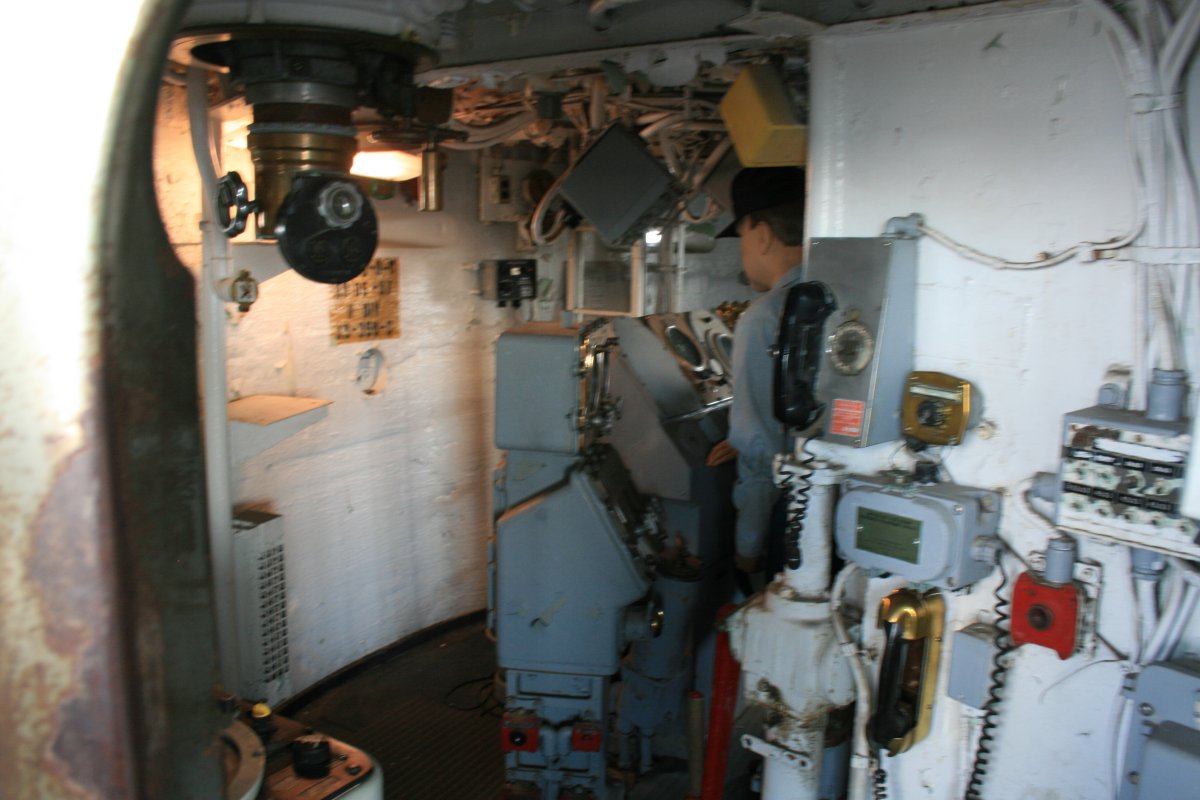 |
|
|
Right here. This is the window of the conning bridge.
|
| |
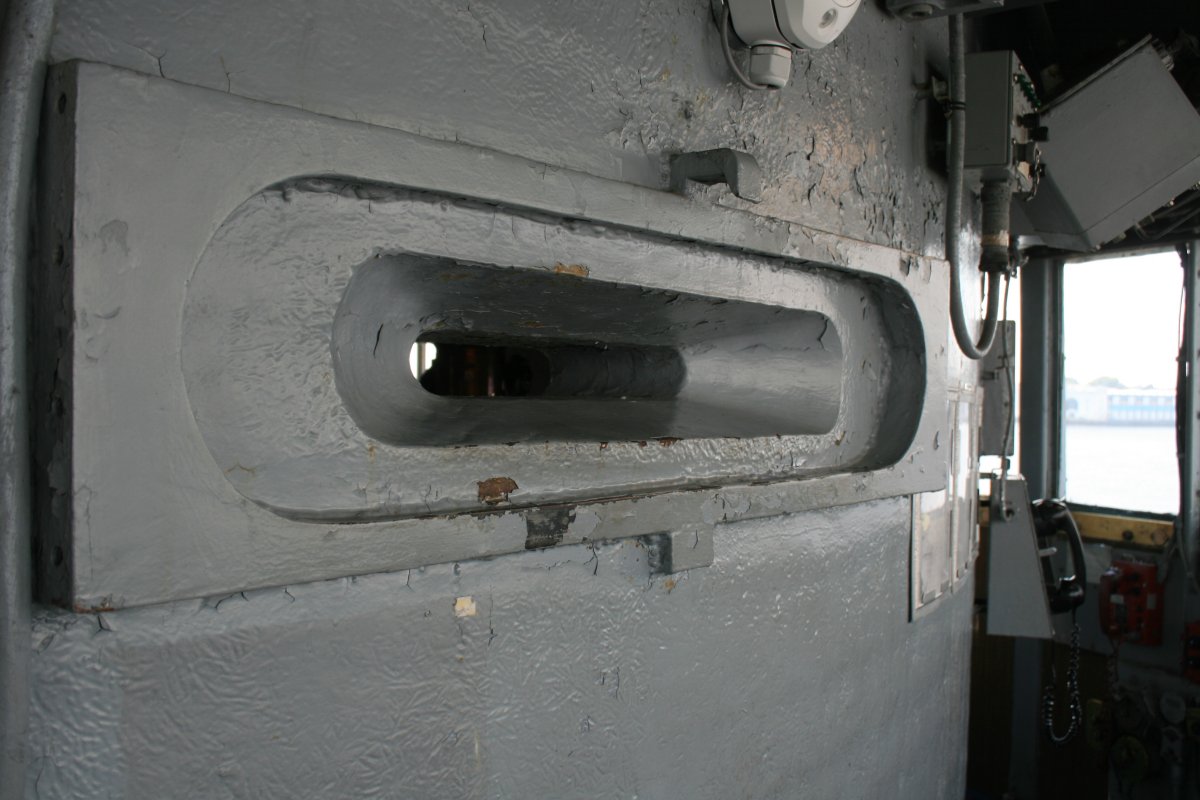 |
|
|
The conning bridge was heavily armored, for obvious reasons. Look at the thickness of that steel door! This ship could take a hit and keep fighting.
|
| |
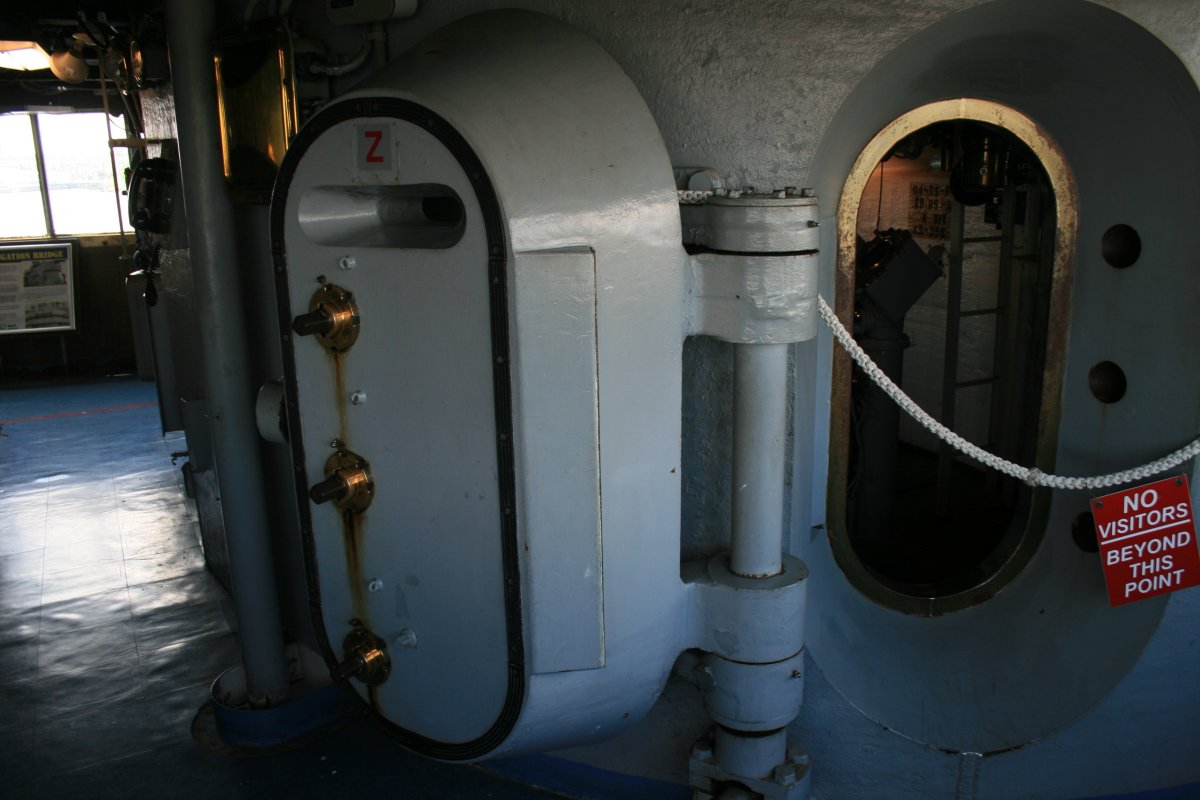 |
|
| During the Reagan administration, the four Iowa-class battleships were reactivated. In addition to the 16-inch main battery, and 5-inch secondary batteries, they were fitted with Harpoon and Tomahawk cruise missiles. This is one of eight Tomahawk quad-launcher the battleship carried. That is a Phalanx CIWS mount on the left. The Phalanx system was a last line of defense against cruise missiles and aircraft. |
| |
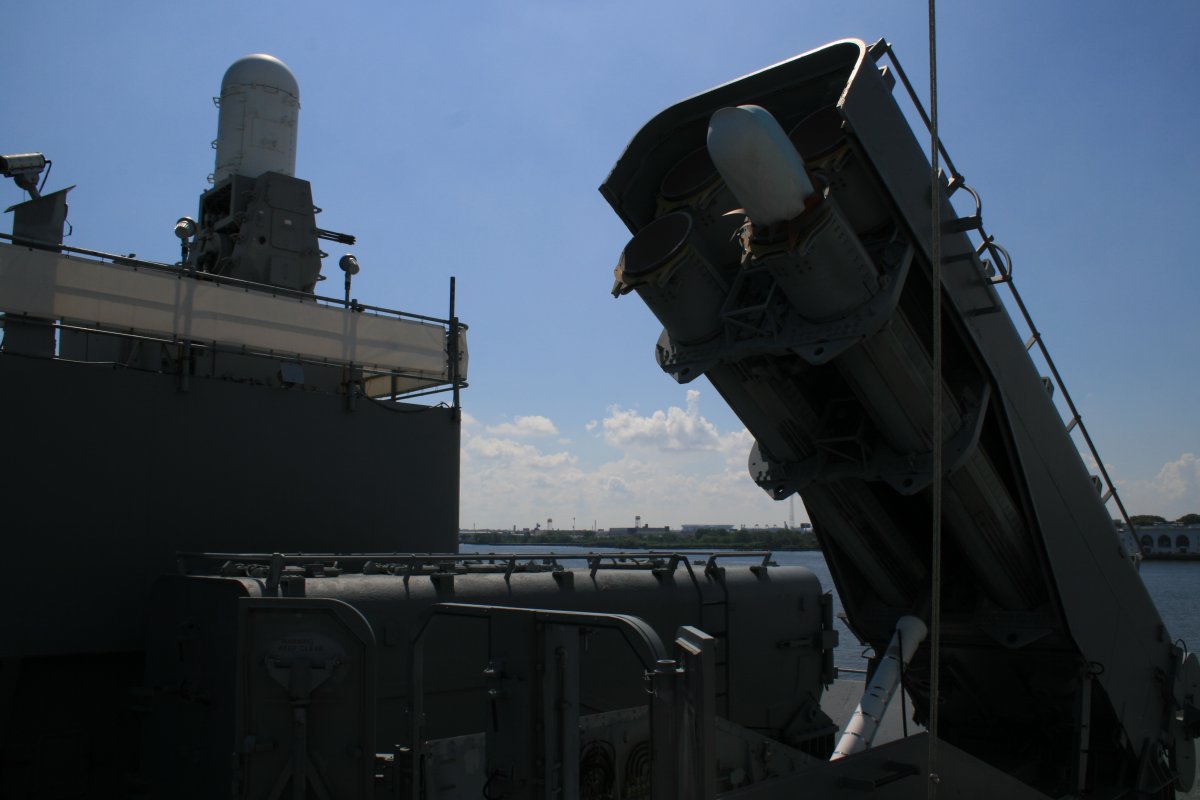 |
|
|
The New Jersey has lots of room inside and is essentially a floating museum.
They had a very good area on battleships. I really enjoyed a series of models which showed the progression from the first battleship -- the HMS Dreadnaught -- to the USS Montana-class.
The battleship below is the one that started it all; the world's first modern battleship: the British HMS Dreadnaught. She was revolutionary. Dreadnought's entry into service in 1906 represented such an advance in naval technology that its name came to be associated with an entire generation of battleships, the "dreadnoughts", as well as the class of ships named after it. Likewise, the generation of ships she made obsolete became known as "pre-dreadnoughts".
Dreadnought was the first battleship of her era to have a uniform main battery -- ten 12-inch guns -- rather than having a few large guns complemented by a heavy secondary armament of smaller guns. She was also the first capital ship to be powered by steam turbines, making her the fastest battleship in the world at the time of her completion: 21 knots. Her launch helped spark a naval arms race as navies around the world, particularly the German Imperial Navy, rushed to match it in the build-up to World War I
|
| |
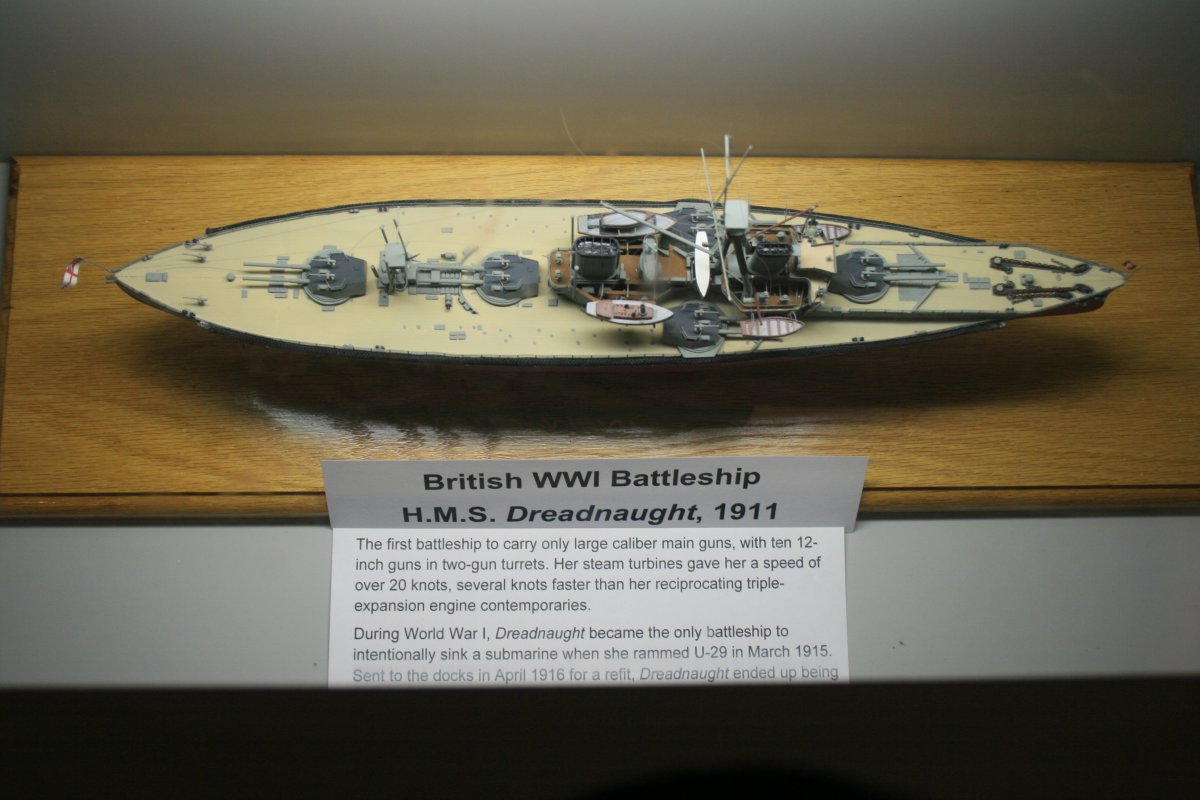 |
|
|
This model of the USS Arizona (BB-39) is a good example of a pre-WWII U.S. battleship. Arizona and the other pre-WWII battleships were built during World War One up into the early 20s. Although the Arizona was blown up at Pearl Harbor, most of the U.S. pre-war battleships were used in WWII for shore bombardment primarily. With a max speed of 23 knots, they were too slow to keep up with the aircraft carriers. Plus they were fuel hogs.
|
| |
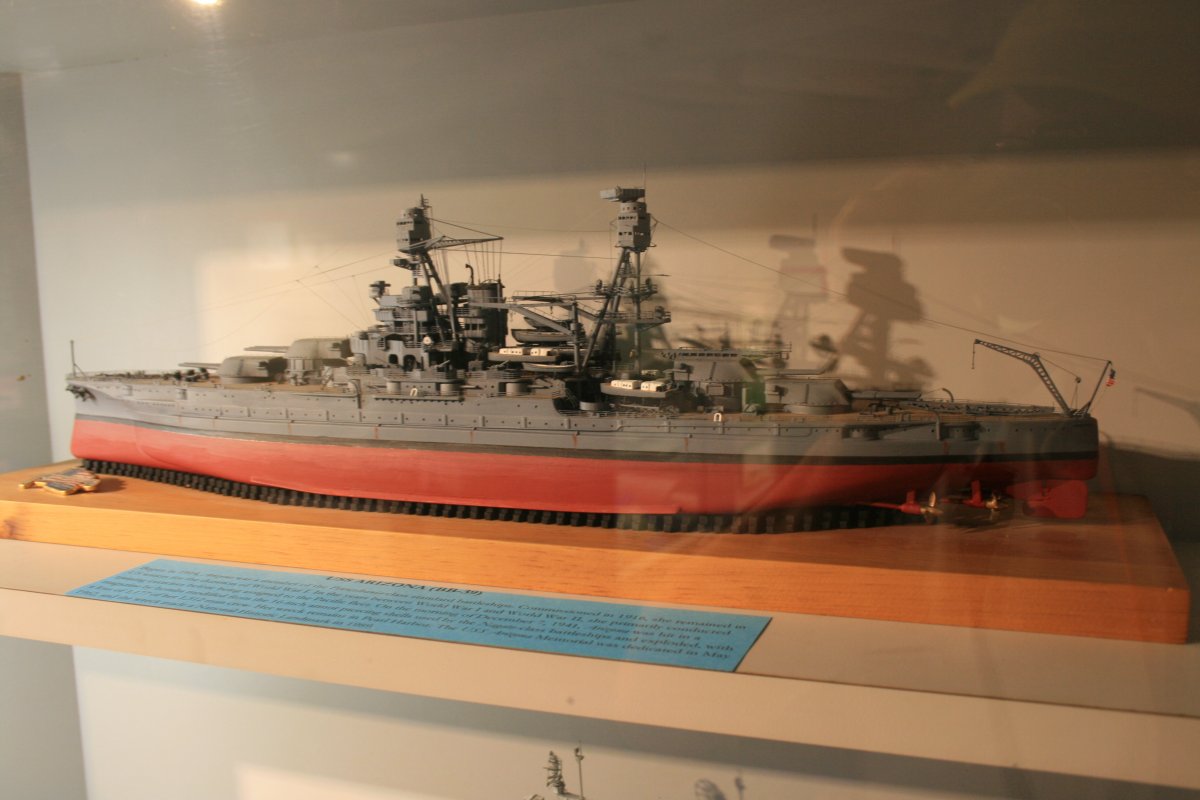 |
|
| Kirishima was one of four Japanese Kongo-class battle cruisers and was built in 1915. It had eight 14-inch guns and could do 30 knots. They were fast battleships that could keep up with the aircraft carriers. Kirishima sank following the night Naval Battle of Guadalcanal on 15 November 1942 from damage delivered by the USS Washington (BB-56) |
| |
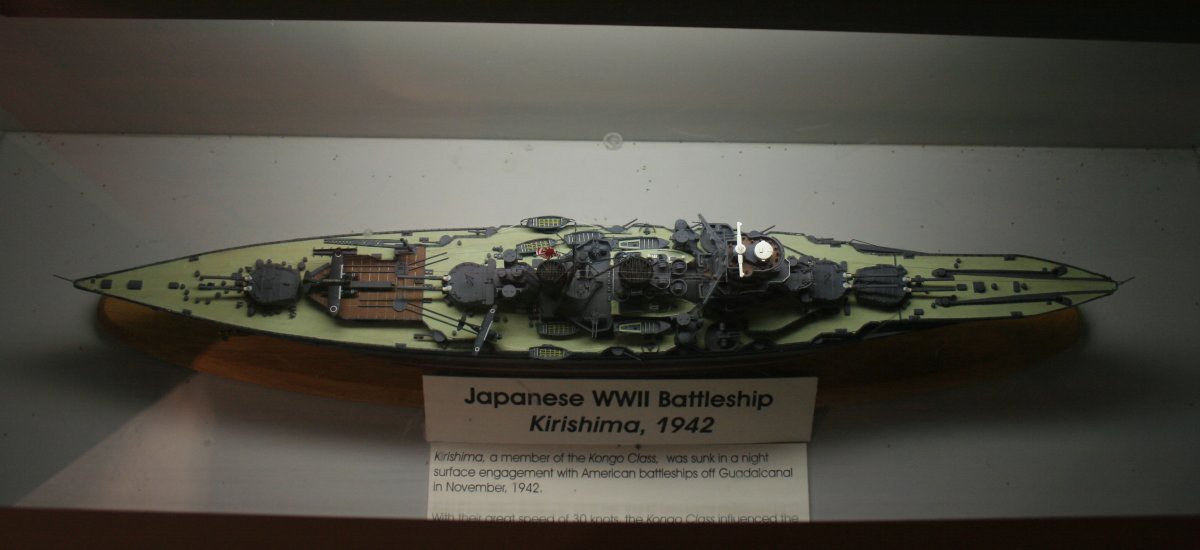 |
|
|
USS North Carolina (BB-55) - North Carolina class. These battleships were fast enough to keep up with the aircraft carriers at 28 knots, had the big 16-inch guns and good armor. They weren't as long as the Iowa class. Both the North Carolina and Washington participated in the Guadalcanal carrier battles. The Washington was a major player in one of the vicious night surface actions off Guadalcanal.
|
| |
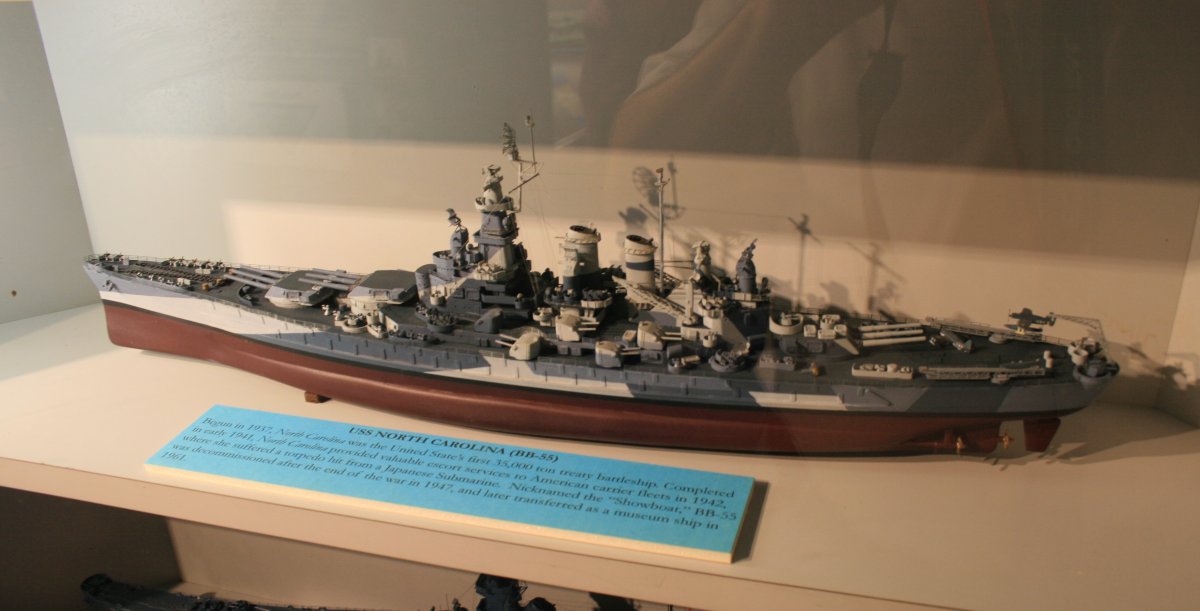 |
|
|
The floating museum had an excellent exhibit on the best battleships of each major combatant in WWII. Each type was evaluated against the standard of the Iowa-class with categories of Protection (Armor), Speed, Firepower and Overall.
This is Italy's top battleship, the Vittorio Veneto class.
|
| |
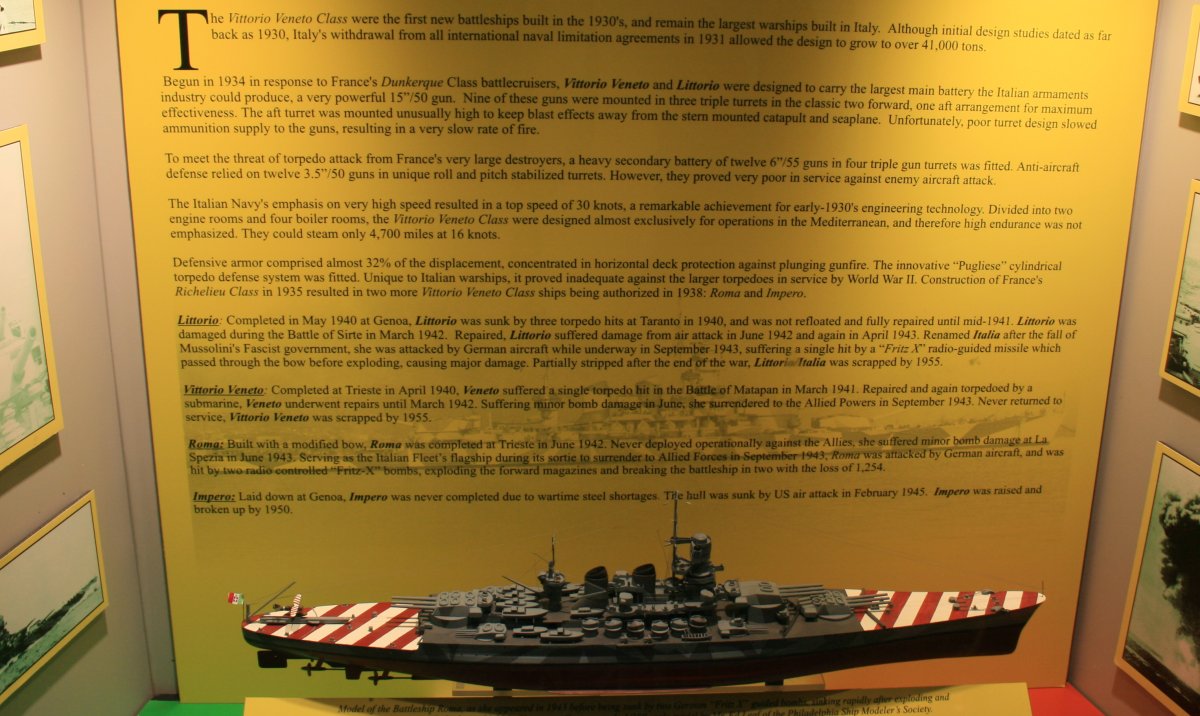 |
|
| Then Germany with the Bismarck class. |
| |
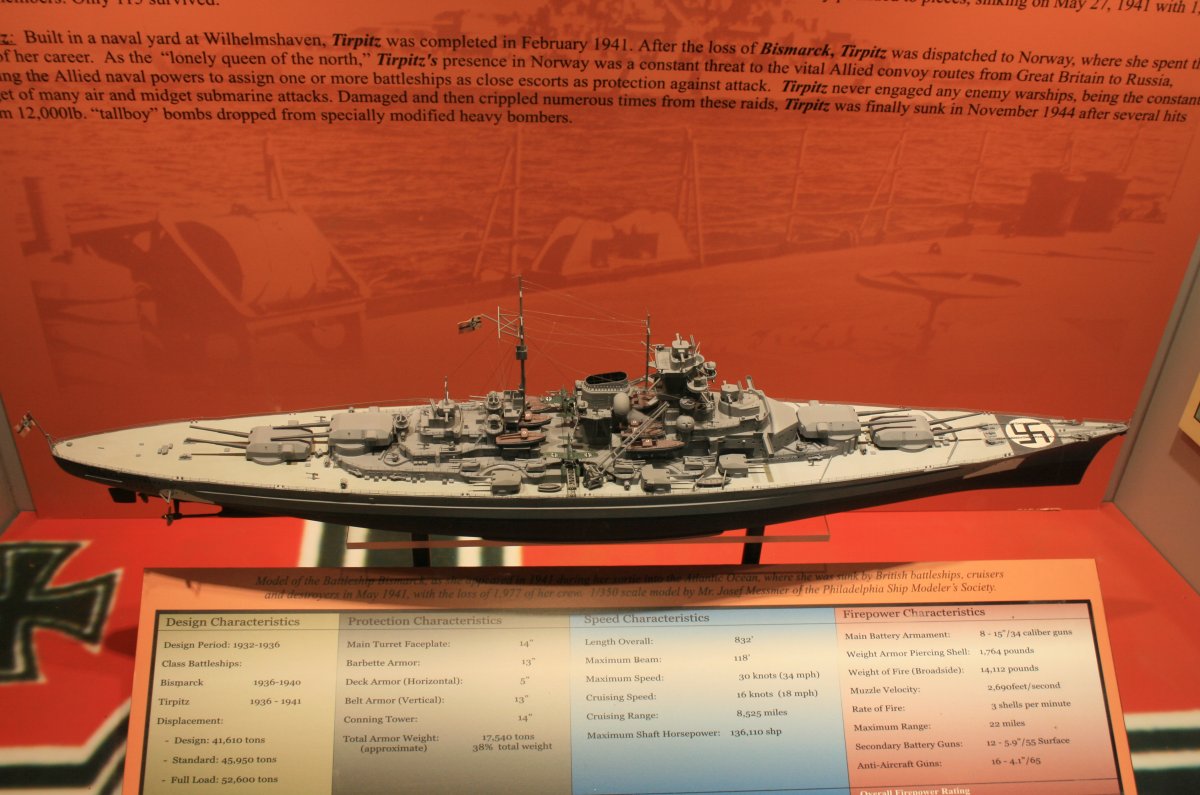 |
|
| Great Britain had the King George V class. |
| |
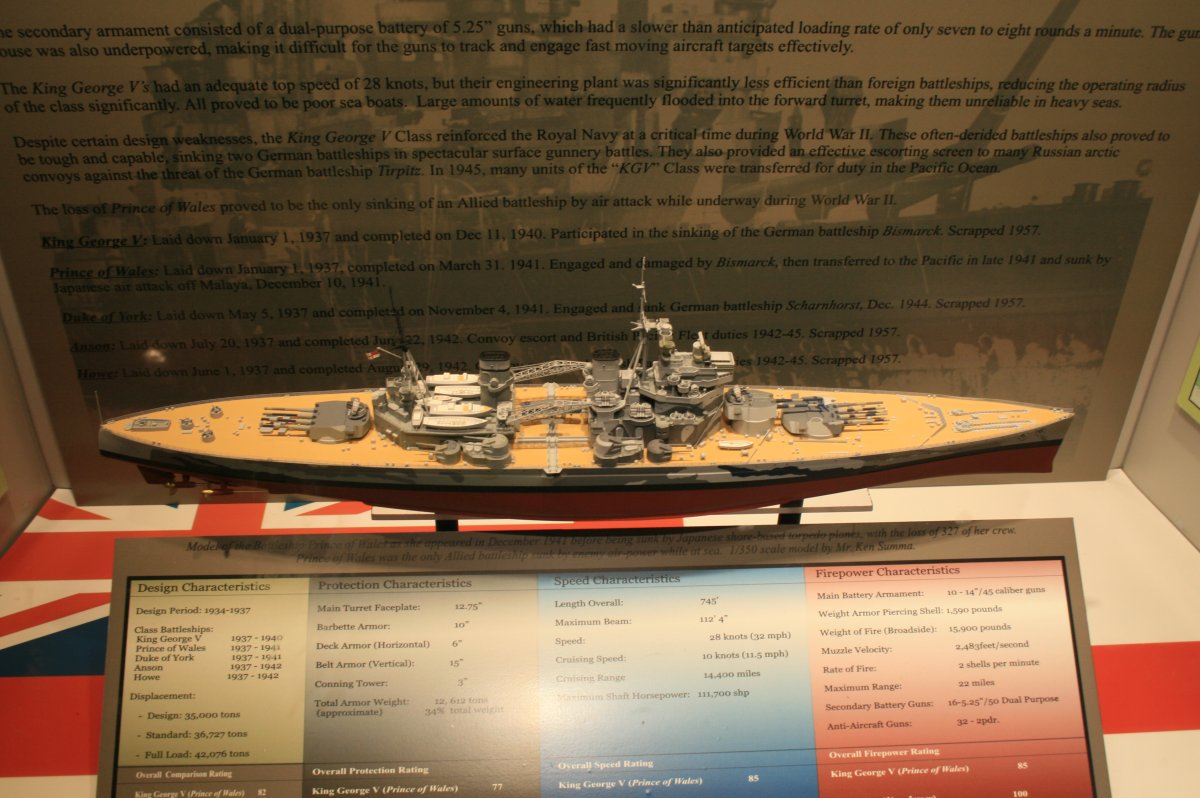 |
|
| And of course Japan with the Yamato class which scored high in firepower with its nine 18-inch guns. |
| |
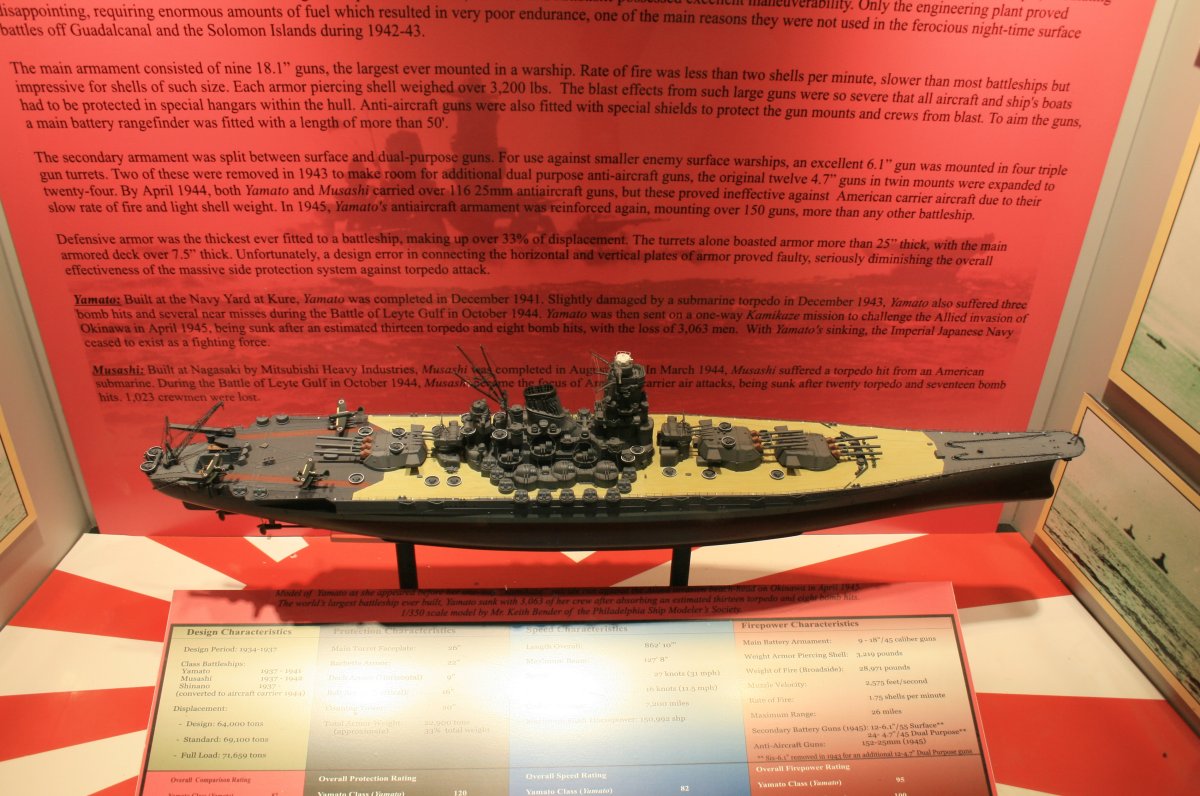 |
|
| And the best overall battleship of them all: the Iowa Class. These battleships were fast at 33 knots, heavily armored, and had awesome firepower, controlled by radar. This model of the New Jersey gives a good look at the half of the ship that is underwater and not visible. |
| |
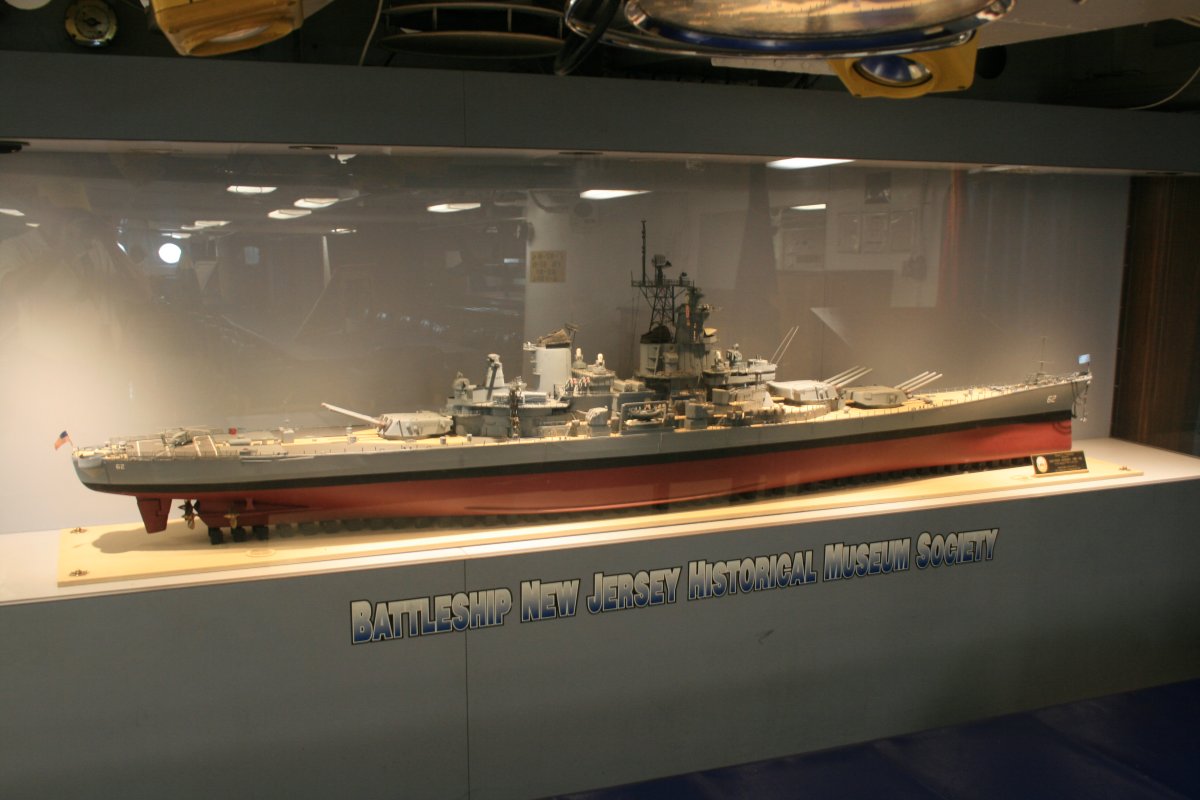 |
|
This is a model of the Montana-class battleship which was to follow the Iowa-class. It would have been better armored, and with superior firepower -- notice the fourth turret with three additional 16-inch guns -- but would have been slower than the Iowas. However, the Montanas were cancelled early in World War II in favor of aircraft carriers. |
| |
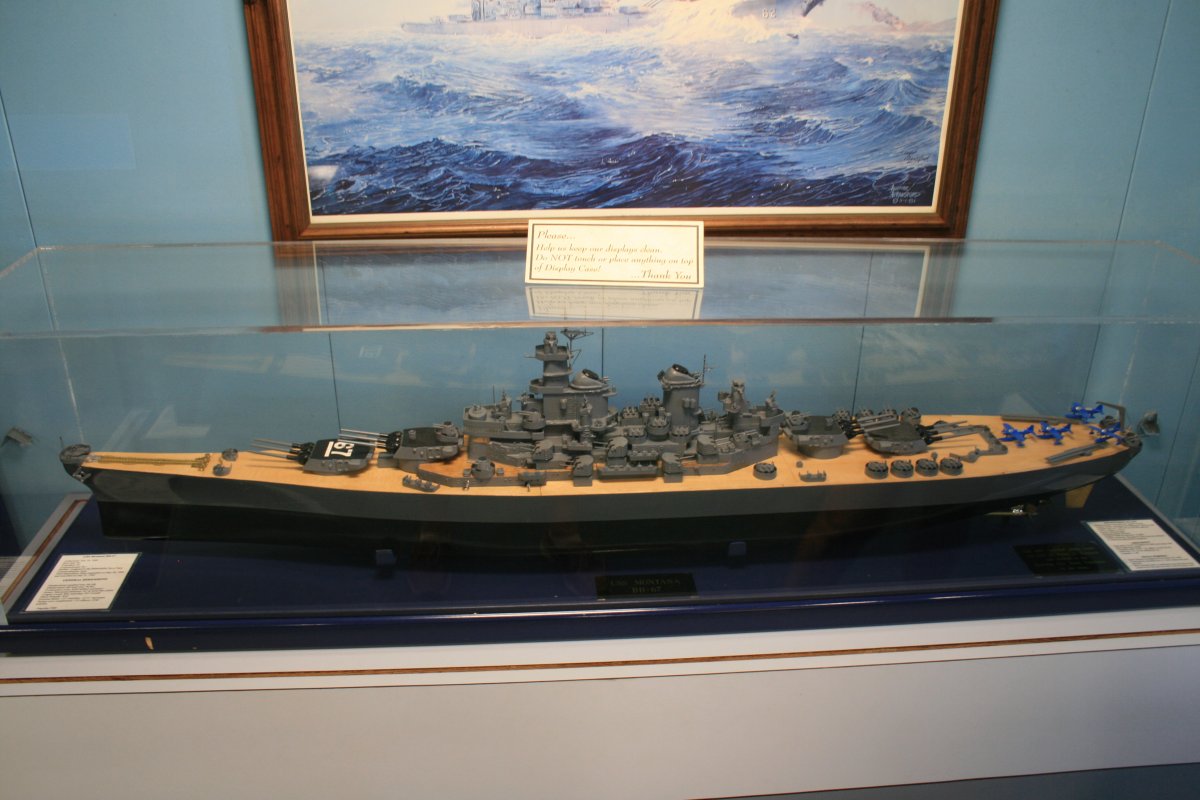 |
|
|
Speaking of 18-inch guns, here is what an 18-inch shell looks like.
|
| |
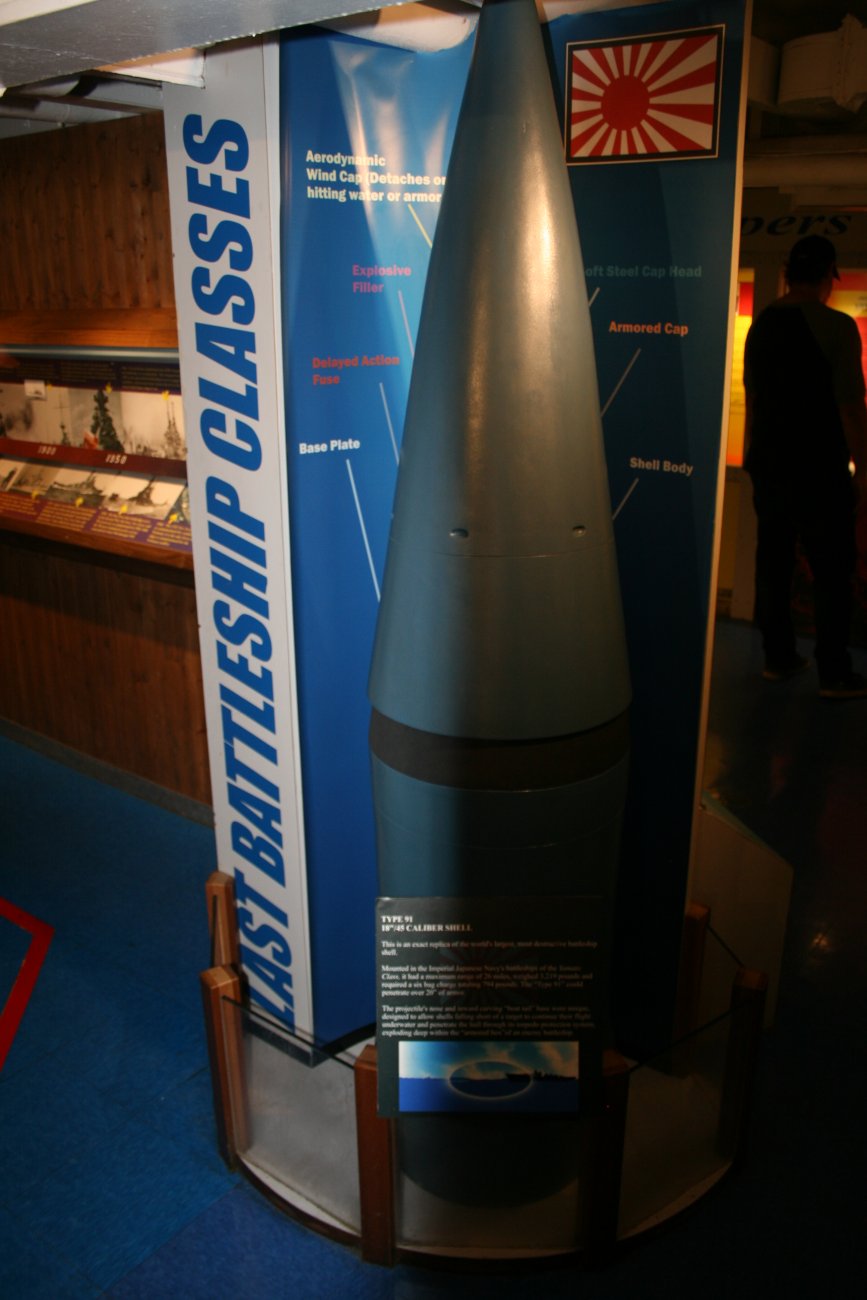 |
|
|
There was a small snack bar in the galley area so we had a quick lunch there. Then we finished touring the ship.
You can see two quad Harpoon launchers in the upper left hand corner. Also visible in this picture is some of the battleship's secondary armament: three dual five-inch gun turrets. To give you some idea of the firepower, most modern naval warships have one five-inch gun, maybe two.
|
| |
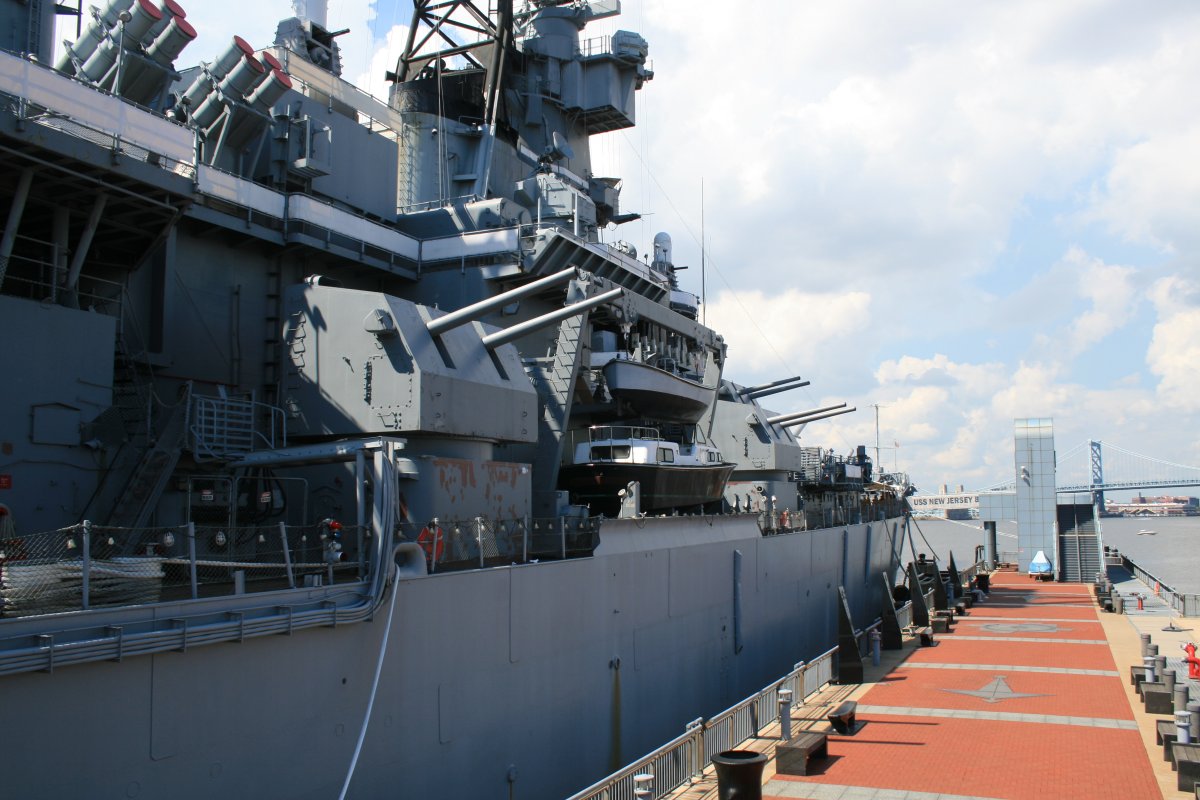 |
|
|
We toured the Flag Quarters area plus the Captain's stateroom. They were not as they were in WWII but you got the idea. It's always amazed me that in World War II, Admirals Spruance and Halsey controlled the massive Fifth and Third Fleets respectively -- hundreds of ships -- from this ship with only HF teletype radios and mimeograph machines!
|
| |
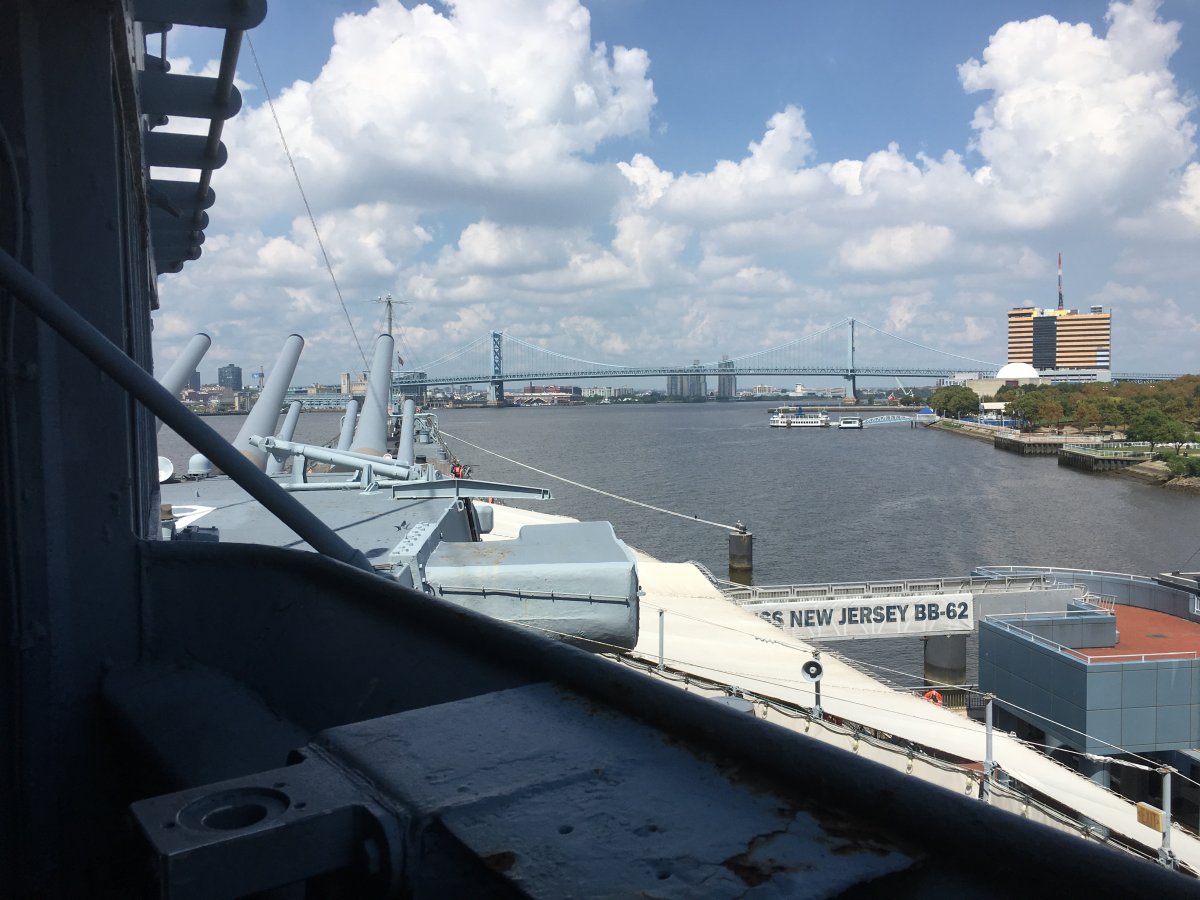 |
|
|
Looking across the river at Philadelpha, and the USS Olympia -- the white ship on the right -- which was a light cruiser in the Spanish-American War of 1898. The Olympia would be our next stop.
The blue ship on the left is the Moshulu, a four-masted steel barque, built in Scotland in 1904. It is currently a floating restaurant.
|
| |
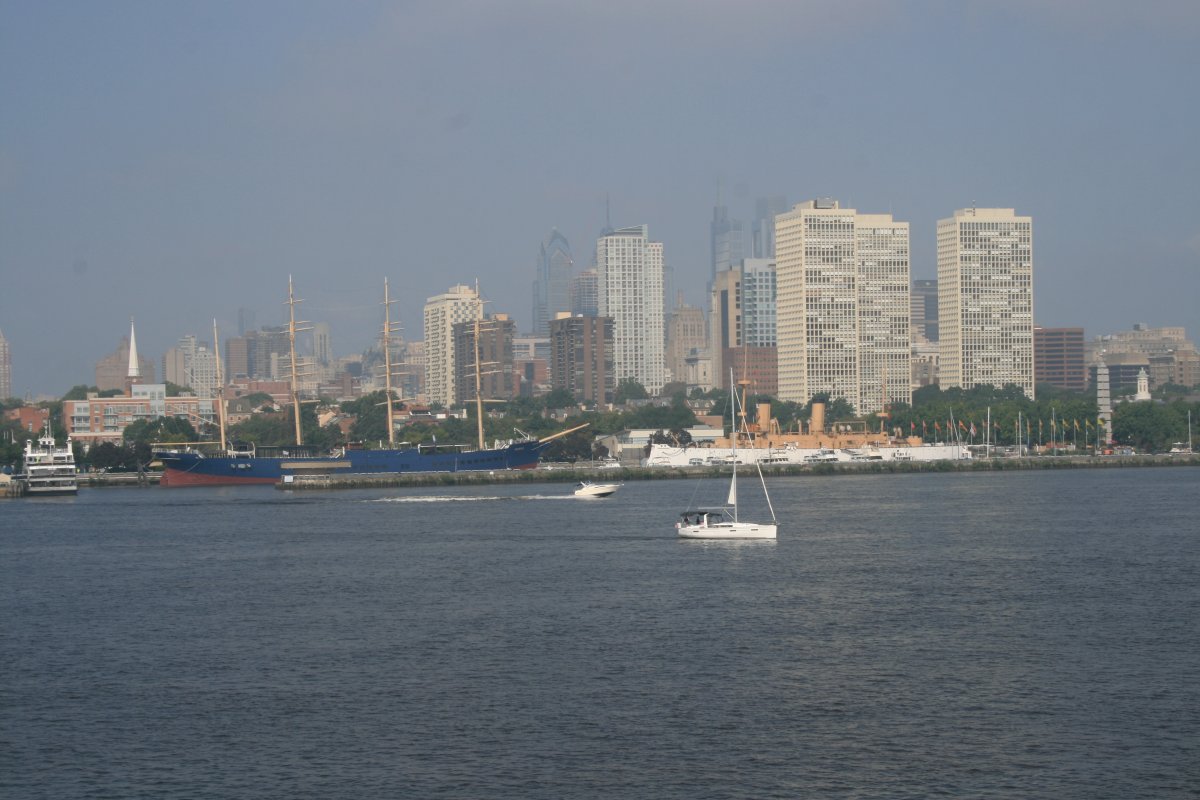 |
|
| Heading back to the car. Seeing the 16-inch gun barrel from the side makes you realize just how big a gun it really is. |
| |
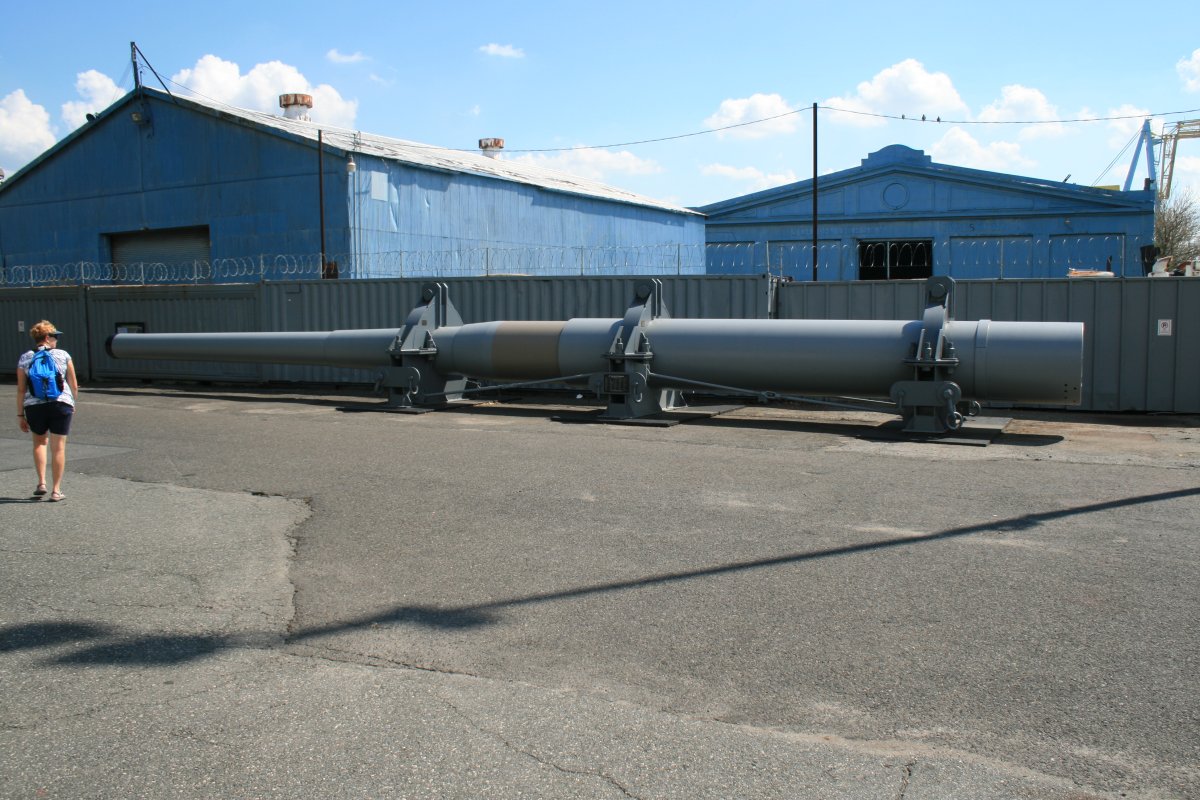 |
|
|
We drove over the Ben Franklin bridge into Philly and down to the river area where the USS Olympia (C-6) was. For such a remarkable piece of history, you rarely here anything about the USS Olympia.
USS Olympia is part of the Independence Seaport Museum so to tour the ship, you have to buy a ticket to the museum. Which was OK, we toured the museum after the ship and it was interesting.
Other than the ticket booth near the gangway, there are no guides or docent. But there are information plaques all over the ship that explain everything. It is well done.
I remember reading years ago that the ship is in serious need of overhaul in a drydock but that, of course, requires a great deal of money, which they are still working on getting. I hope they get it, because it would be a tragedy to lose this ship. Frankly, there are WWII aircraft carriers, battleships, and subs all over the USA but nothing like this.
Right away, when I saw a gun sticking out of a glass window, I knew we weren't on the USS New Jersey anymore.
|
| |
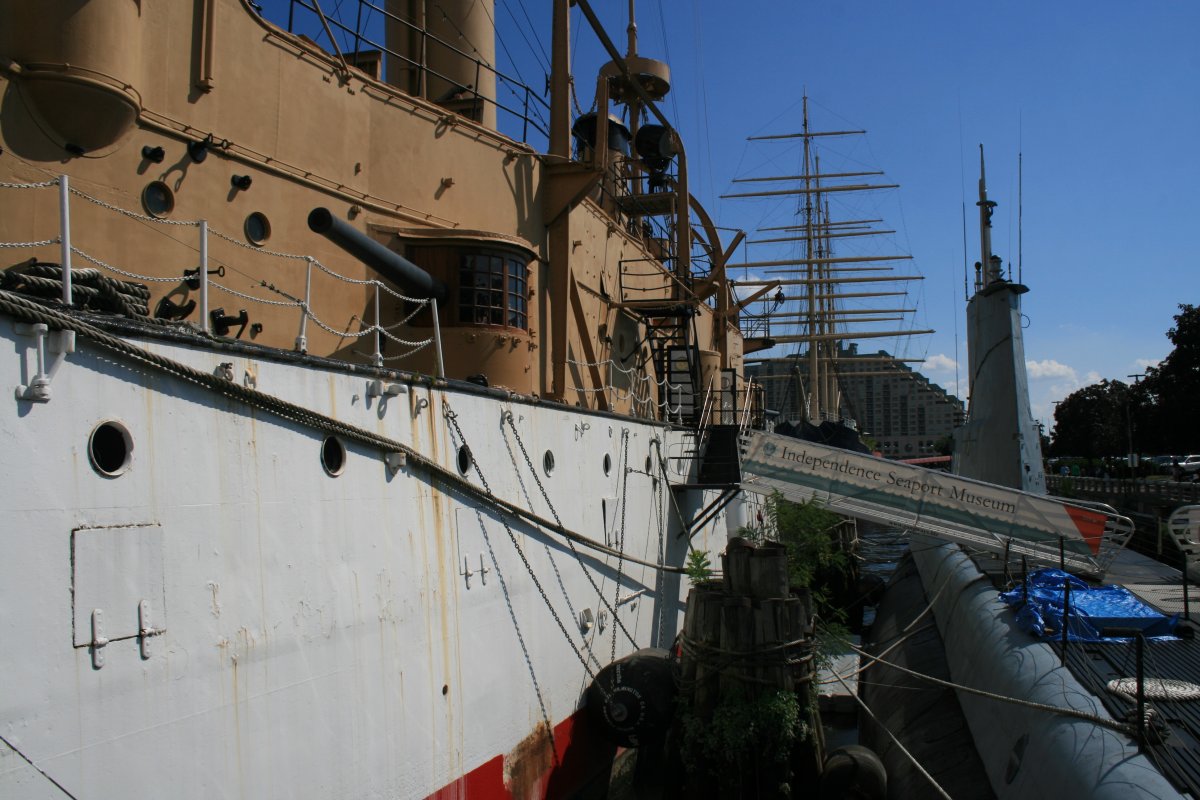 |
|
|
A good shot of the USS Olympia's bow. USS Olympia was commissioned in 1895 and was considered a light cruiser. For power, she burned coal to produce steam for the engines. She had four eight-inch guns and ten five-inch guns. The ship is famous as the flagship of Commodore George Dewey at the Battle of Manila Bay during the Spanish–American War in 1898.
To the left is the World War II submarine USS Becuna (SS-319). We did not go on the sub; I've been in a million of them.
|
| |
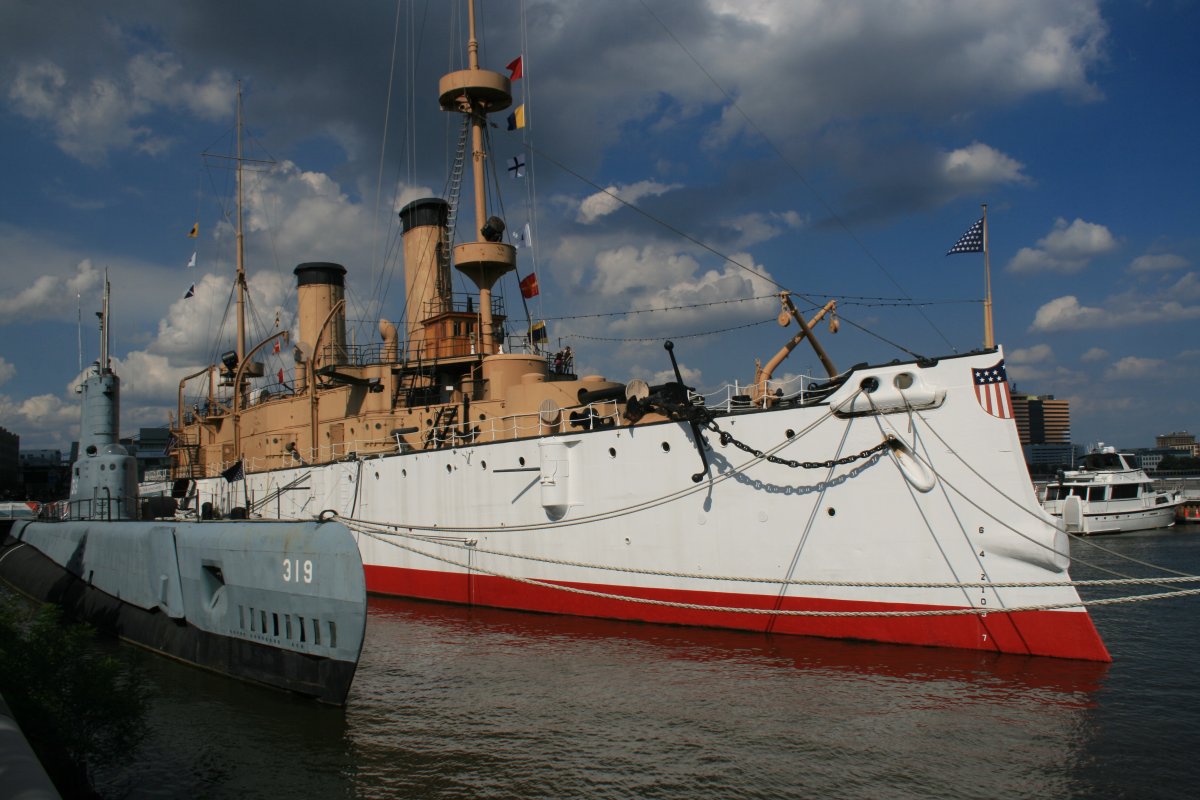 |
|
| The guns sticking out the glass windows are the five-inch guns. You can see two eight-inch guns in the aft turret. |
| |
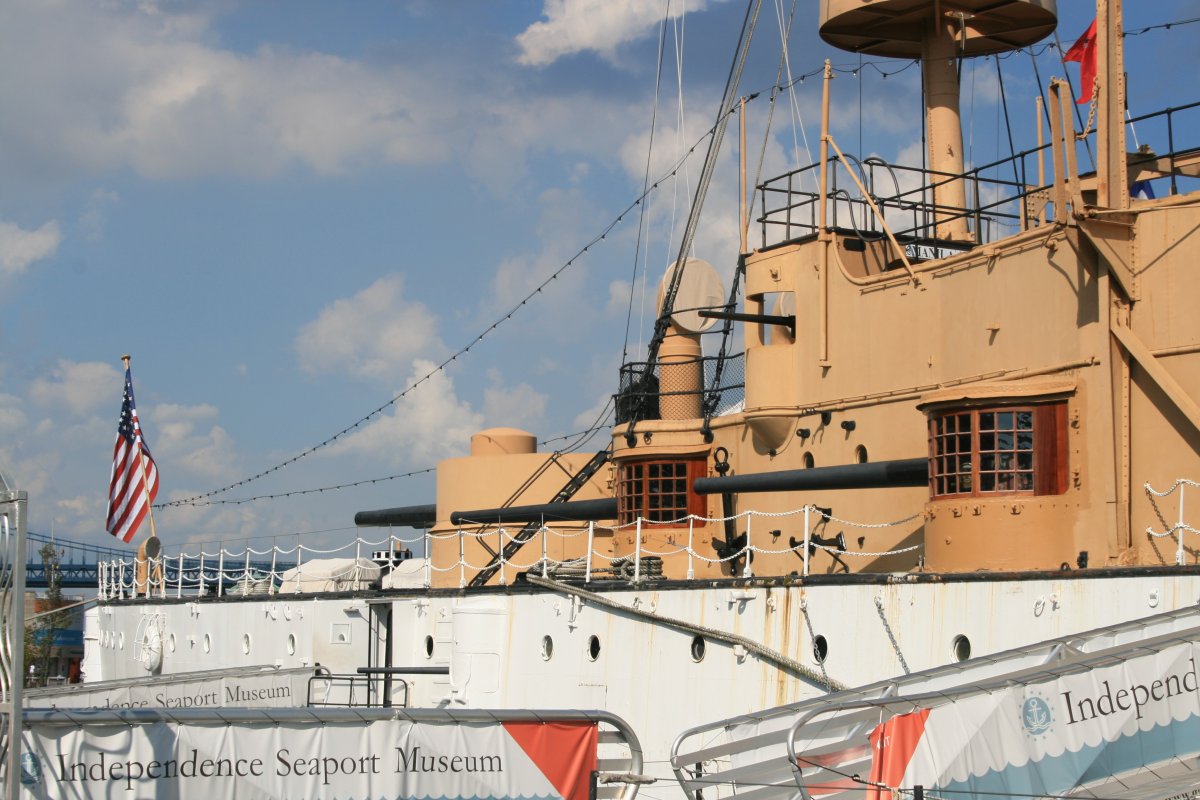 |
|
|
A model of the USS Olympia. It is pretty amazing how far naval warship technology advanced from the USS Olympia in 1898 to the USS New Jersey in 1942: only 44 years later.
|
| |
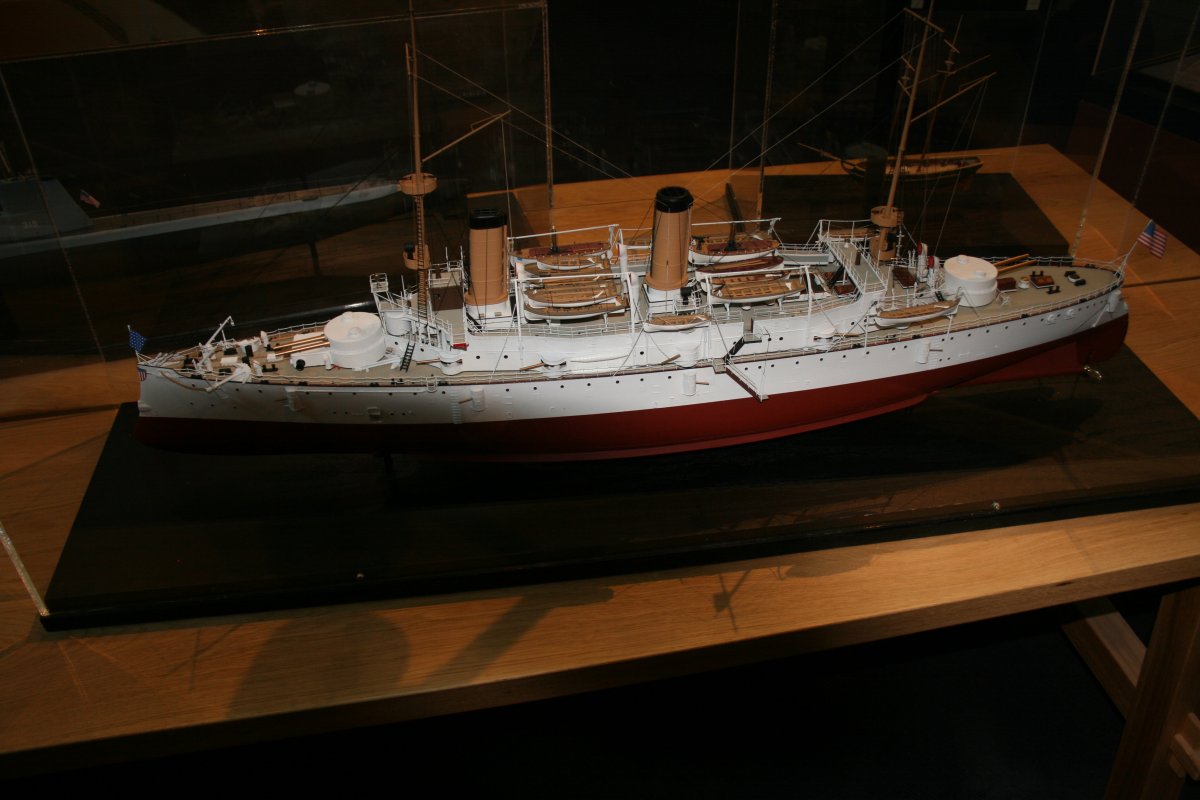 |
|
| Lynnette standing next to a 6-pounder 57mm gun. |
| |
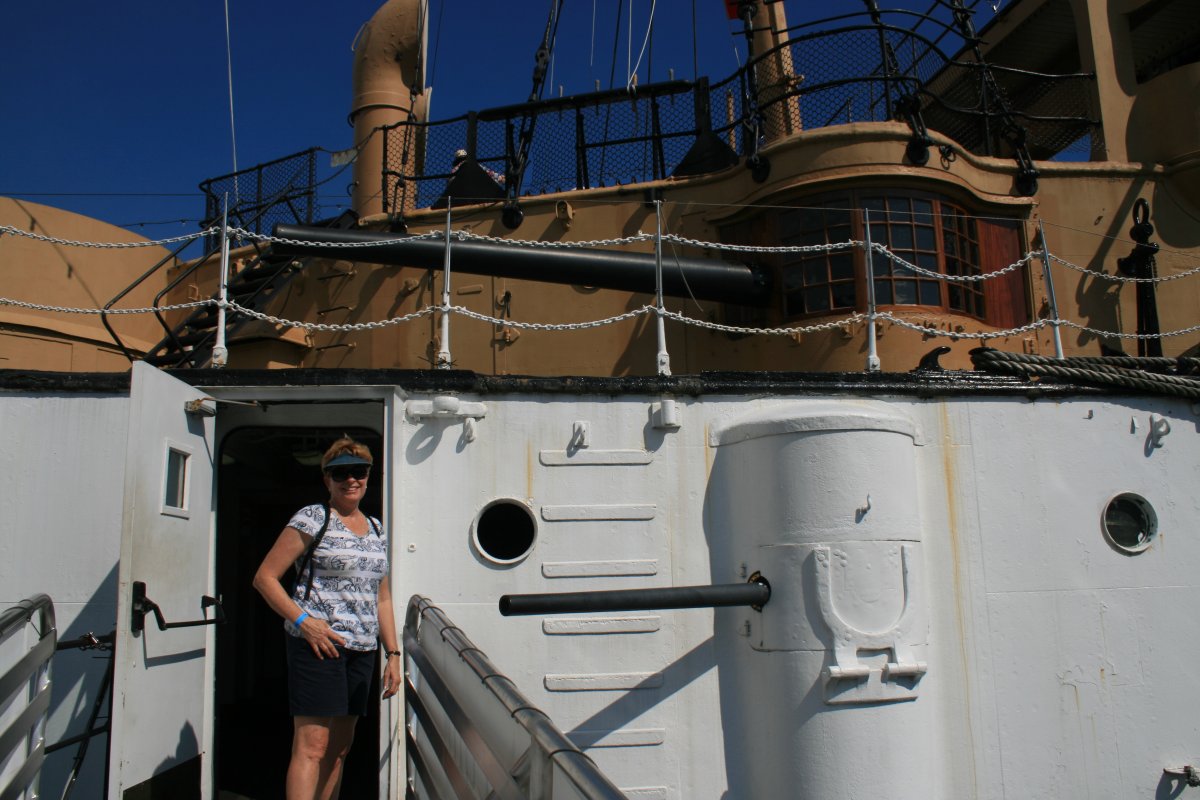 |
|
|
Inside, I was amazed to see wood floors and wood panelling in officer country. Fire at sea is not a good thing.
|
| |
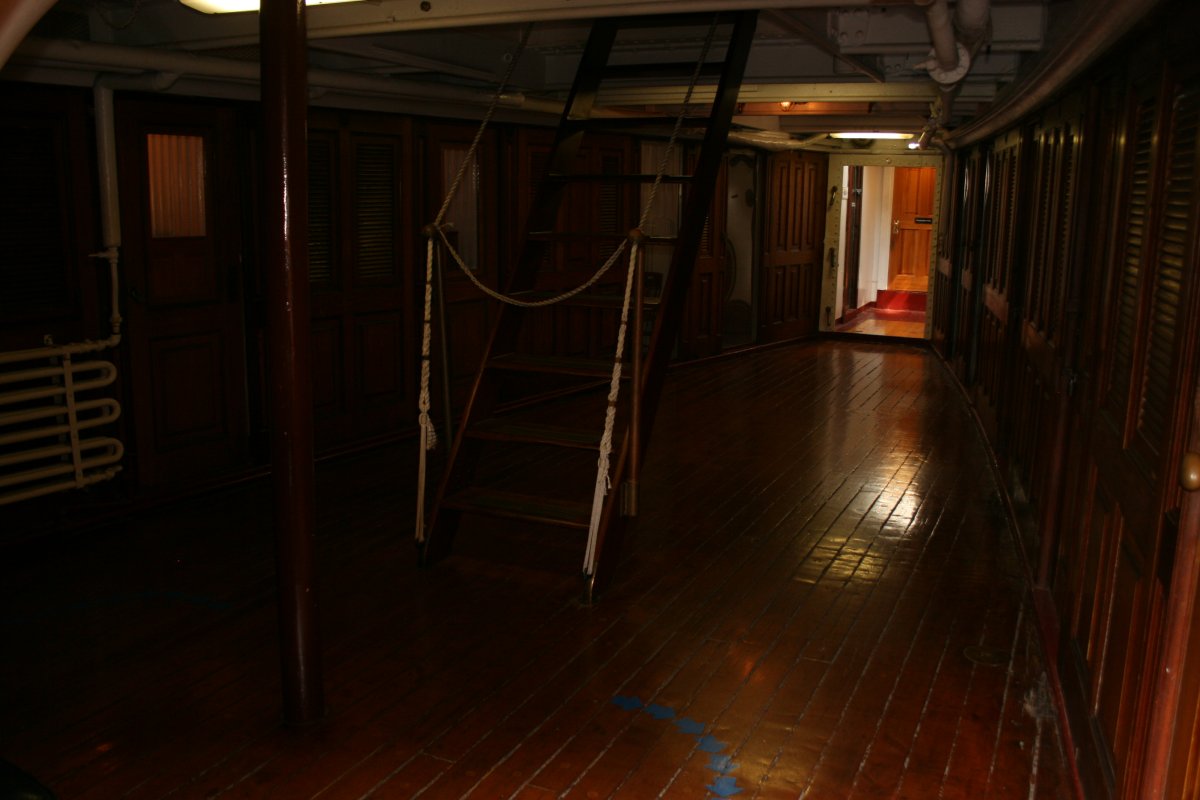 |
|
| This compartment contained the ship's machine shop. All the tools were belt-driven off a steam engine somewhere, of course. |
| |
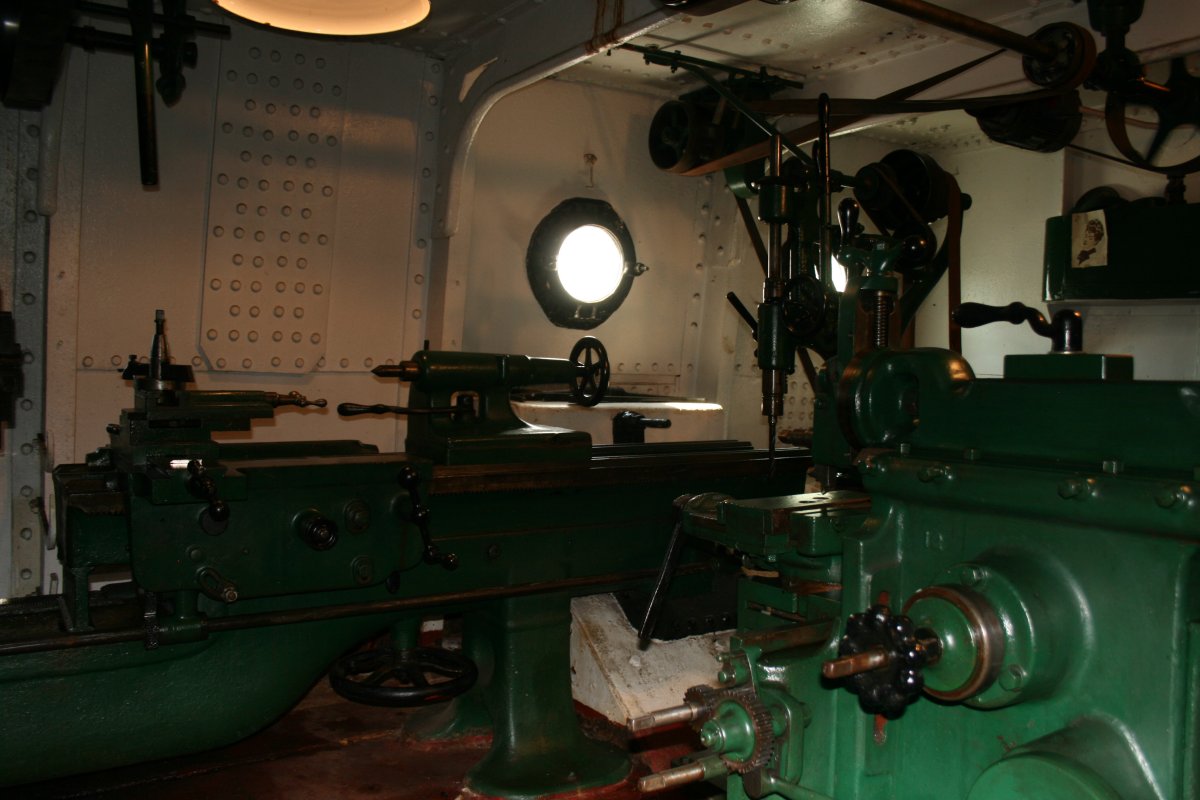 |
|
|
One of the 37mm guns poking out the side.
|
| |
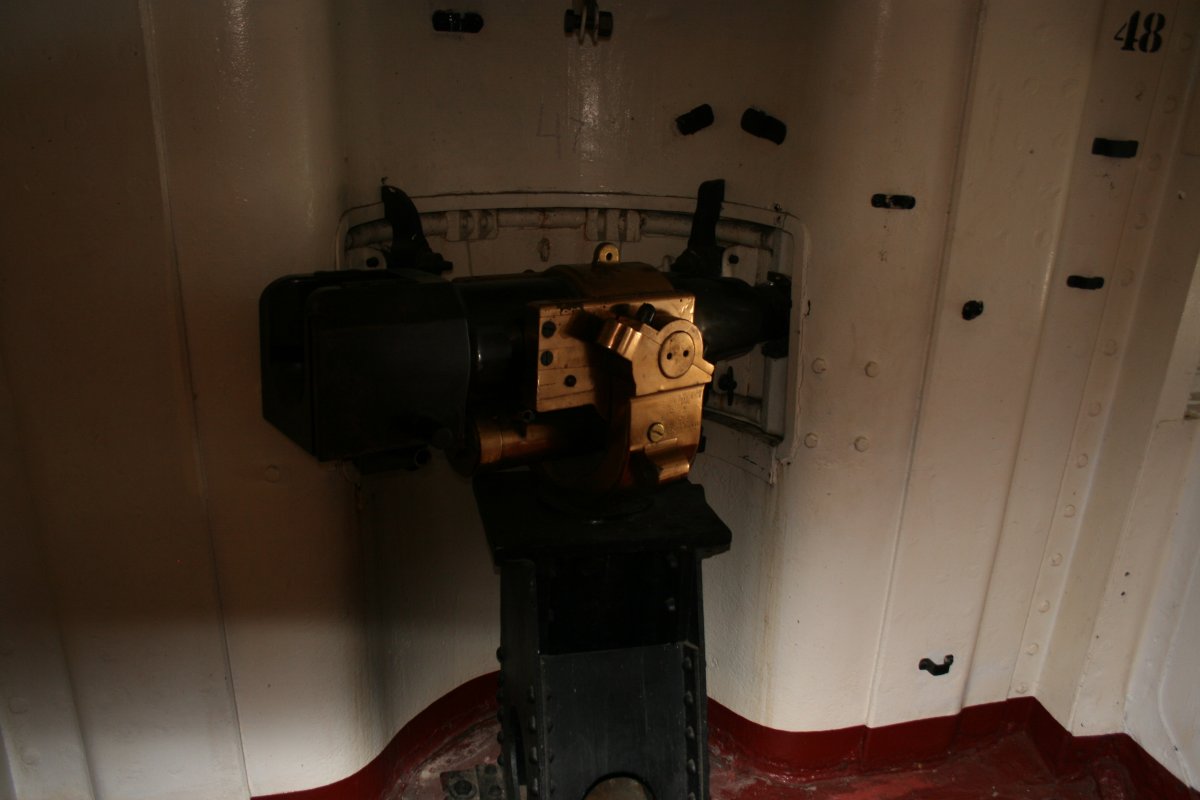 |
|
| One of the big five-inch guns. |
| |
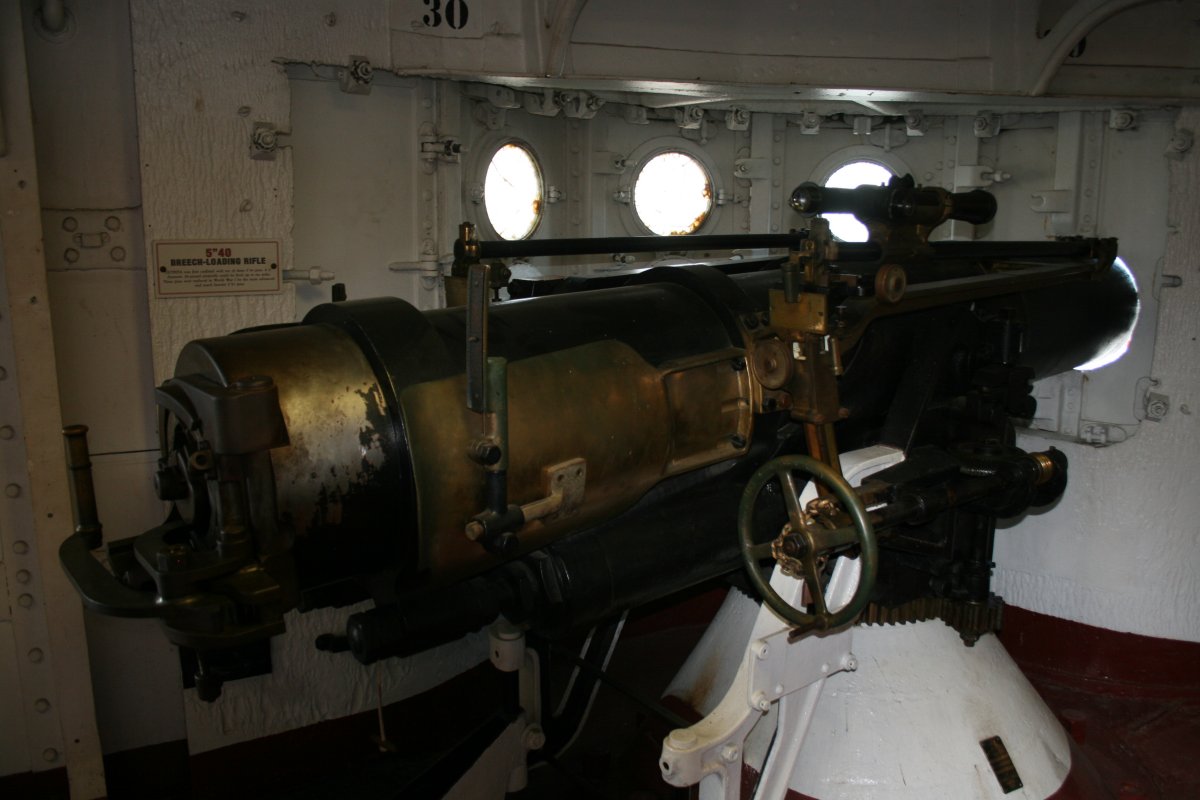 |
|
|
Aft steering.
|
| |
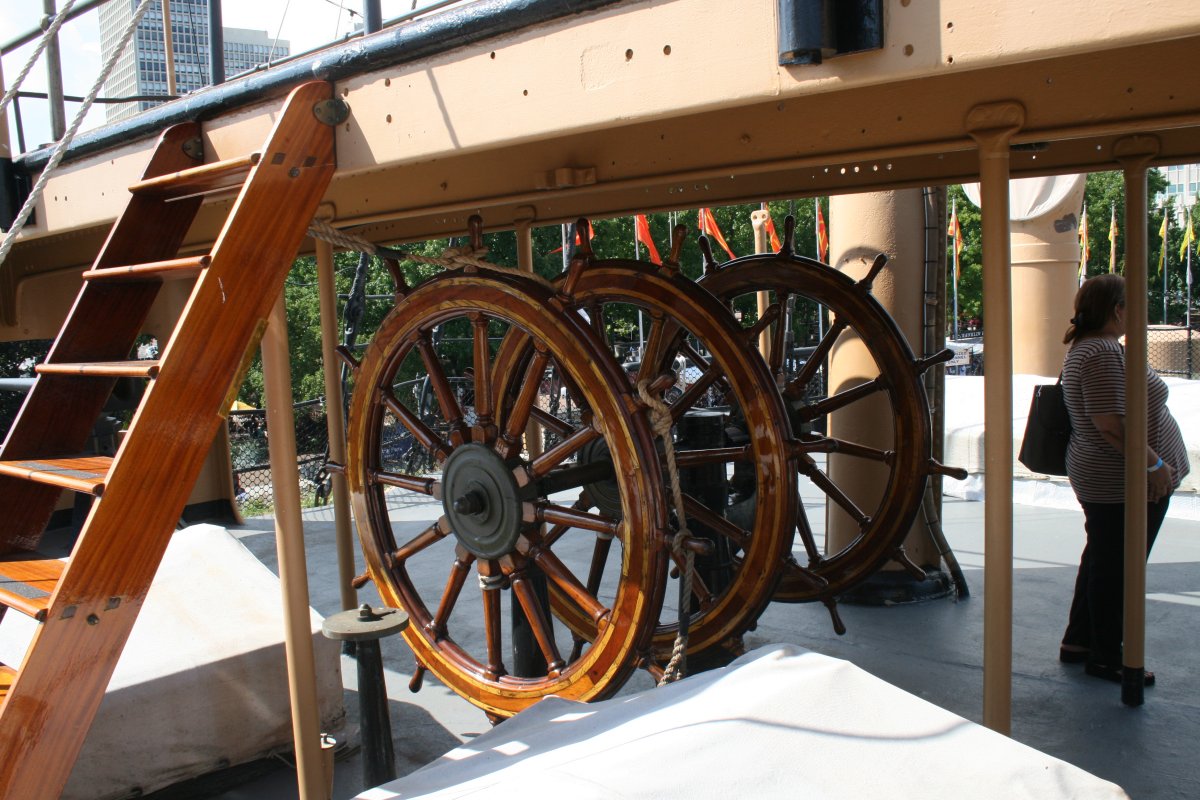 |
|
| Looking aft over the twin eight-inch gun turret. |
| |
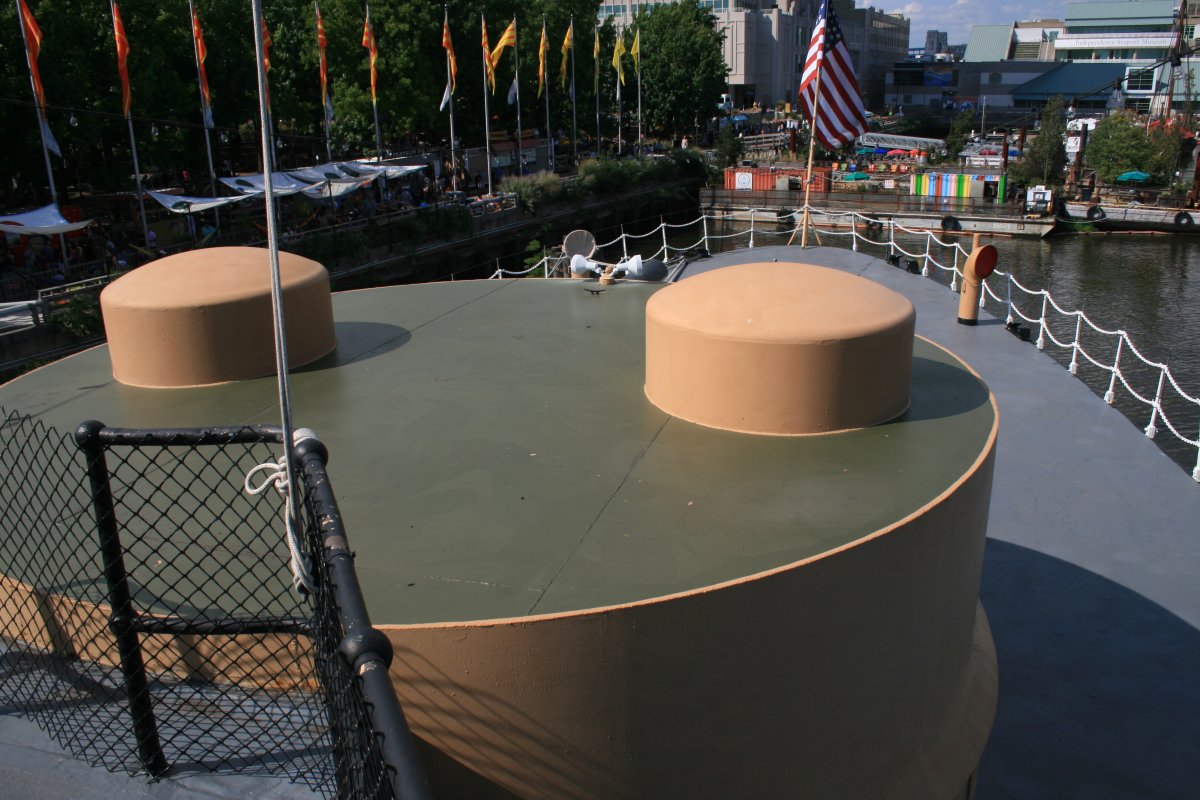 |
|
|
Now looking forward over both twin eight-inch gun turrets.
|
| |
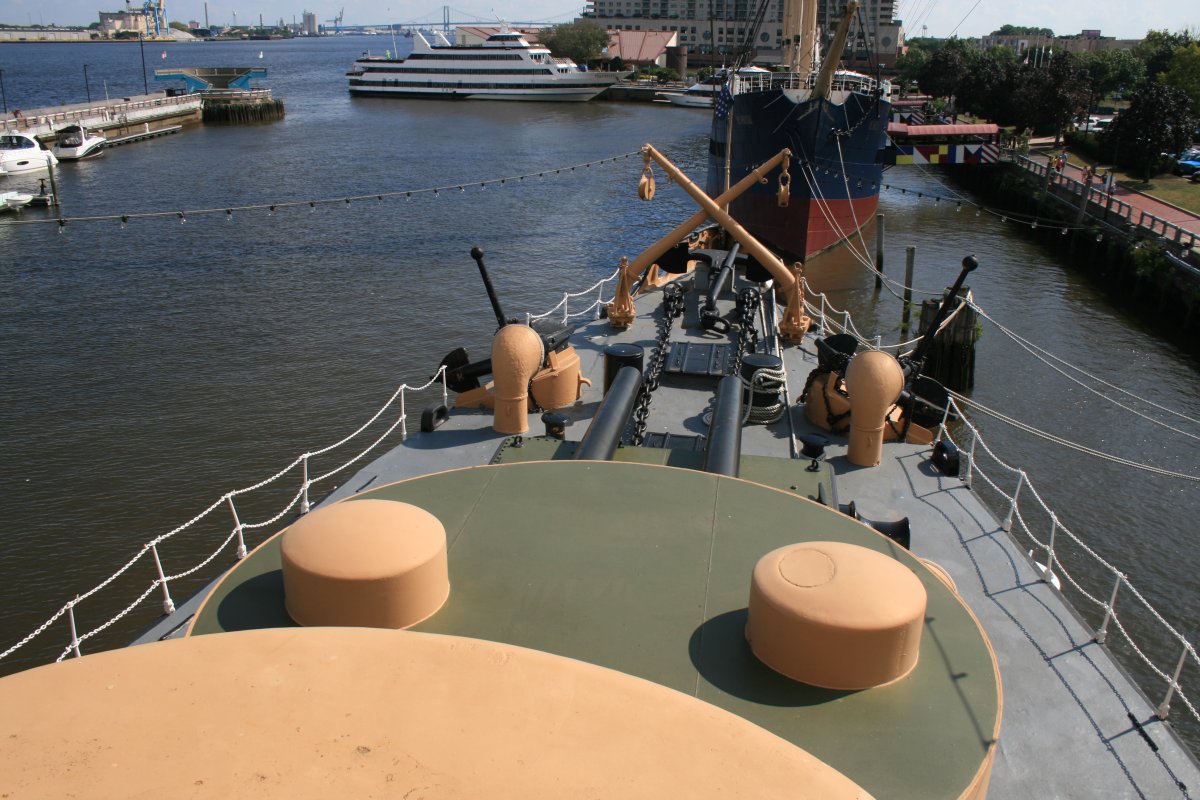 |
|
|
Where Commodore Dewey stood directing the Asiatic Squadron to victory in the Spanish American War at Manila Bay, Phillippines: May 1, 1898.
"You may fire when ready, Gridley" is one of the great lines in U.S. Navy history. I had to memorize it as a plebe at the Naval Academy.
|
| |
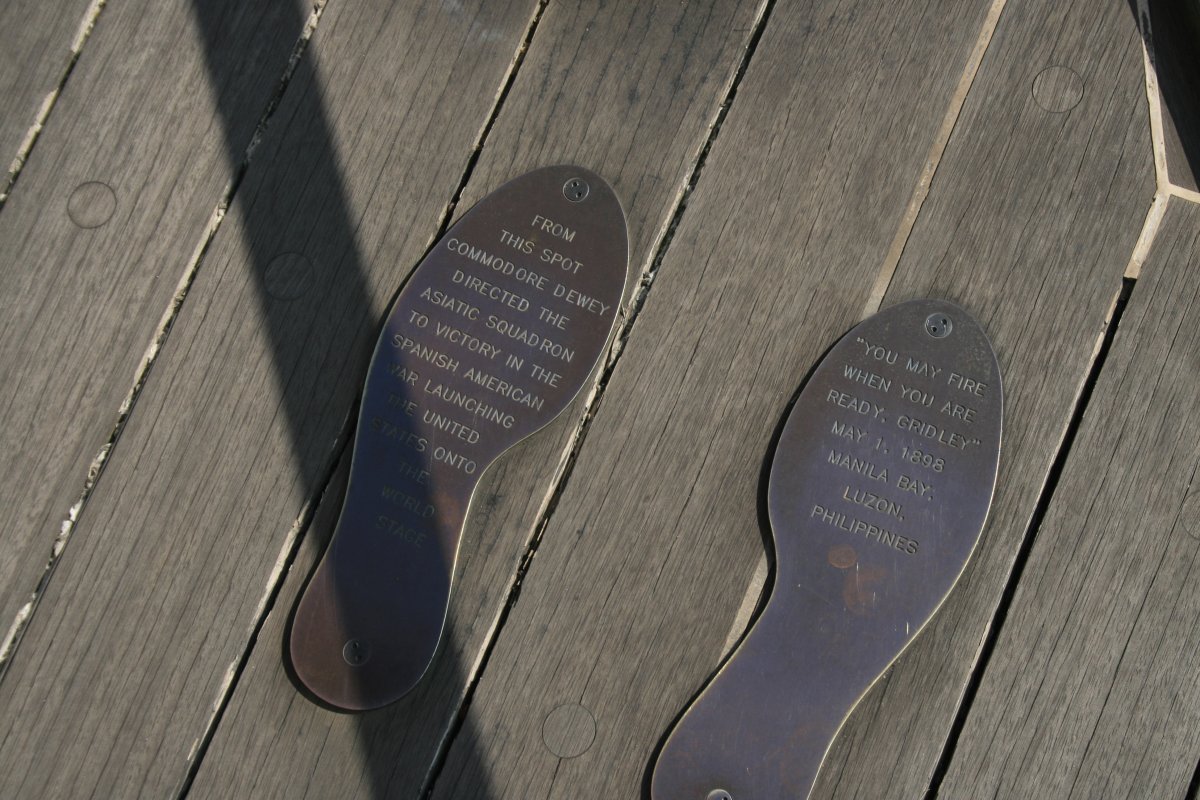 |
|
|
I was shocked to see the flimsy wooden bridge and conn; not much protection in a naval battle.
|
| |
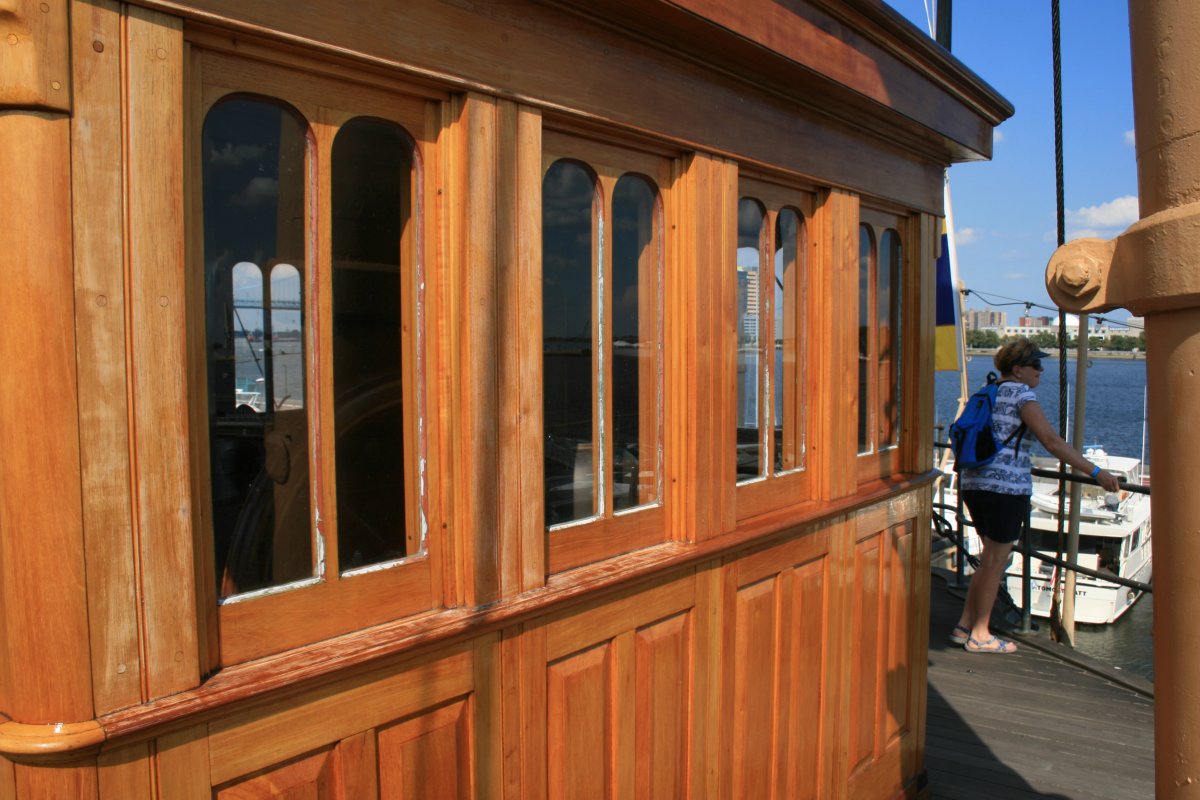 |
|
| A close up of the Moshuhu which is a floating restaurant. Have to try it someday. |
| |
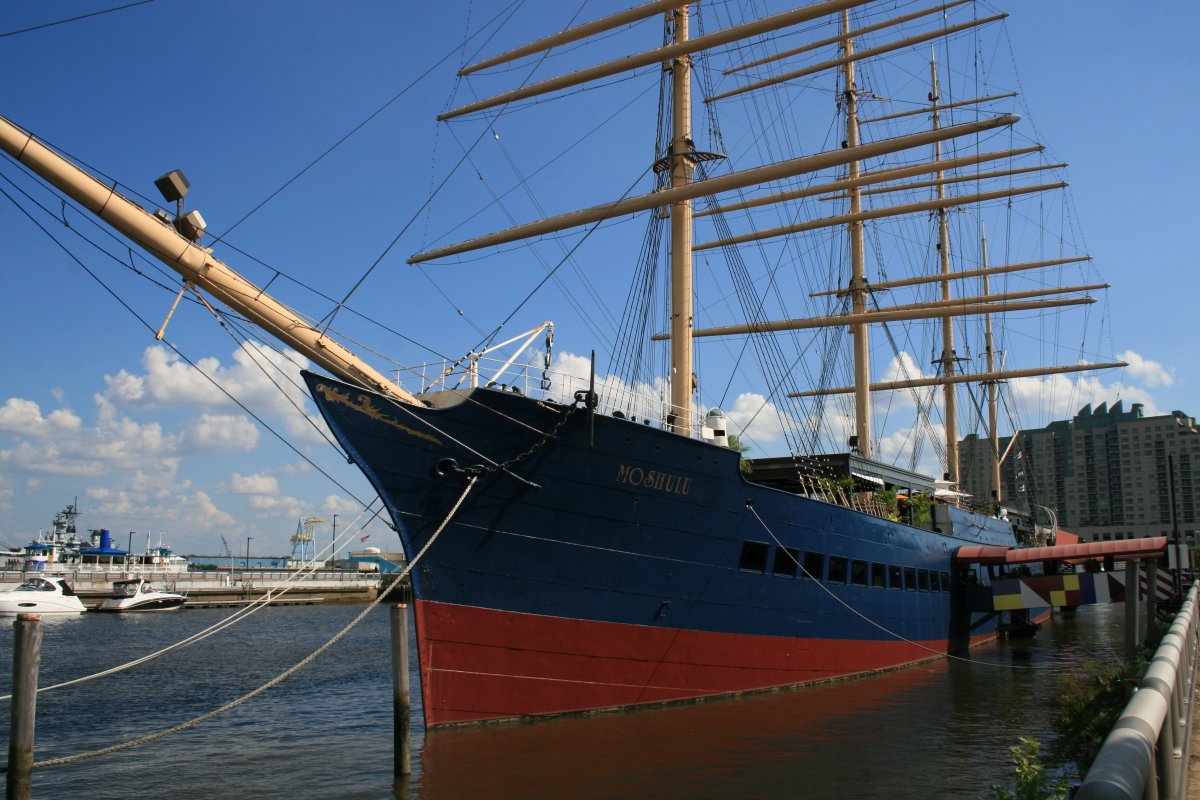 |
|
|
We left the USS Olympia and toured the Independence Seaport Museum. This is a diorama of the Philadelphia shipyard where they built the U.S. Navy's first frigate: the 44-gun United States, launched in 1797
|
| |
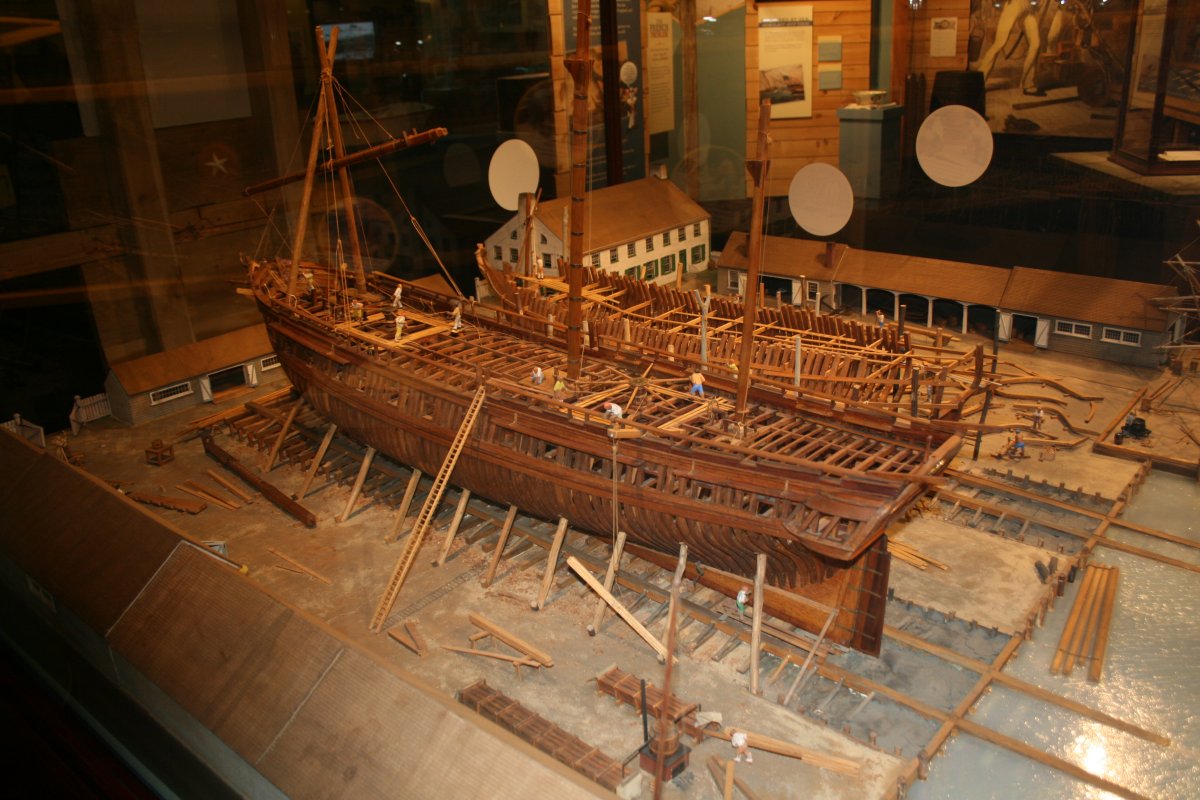 |
|
|
From another angle.
|
| |
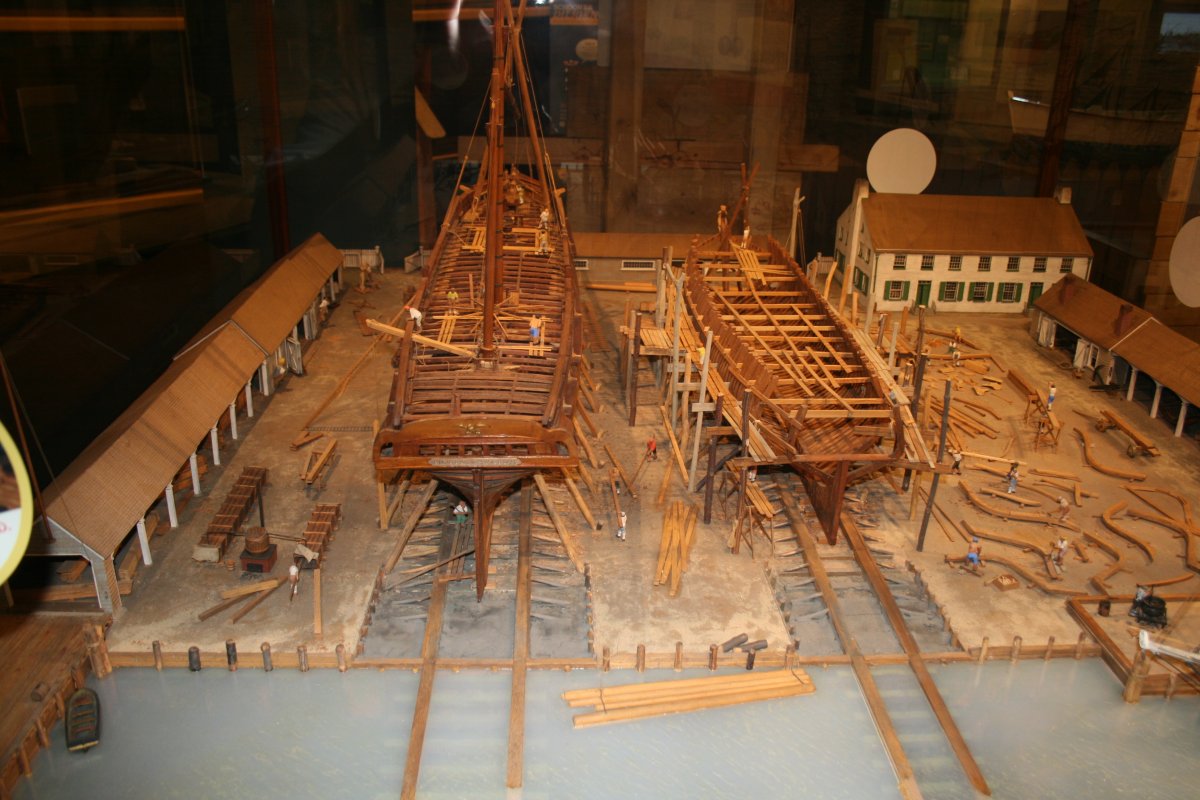 |
|
| A model of the U.S. Navy's second frigate, the famous USS Constitution, which was a sister ship of the USS United States. |
| |
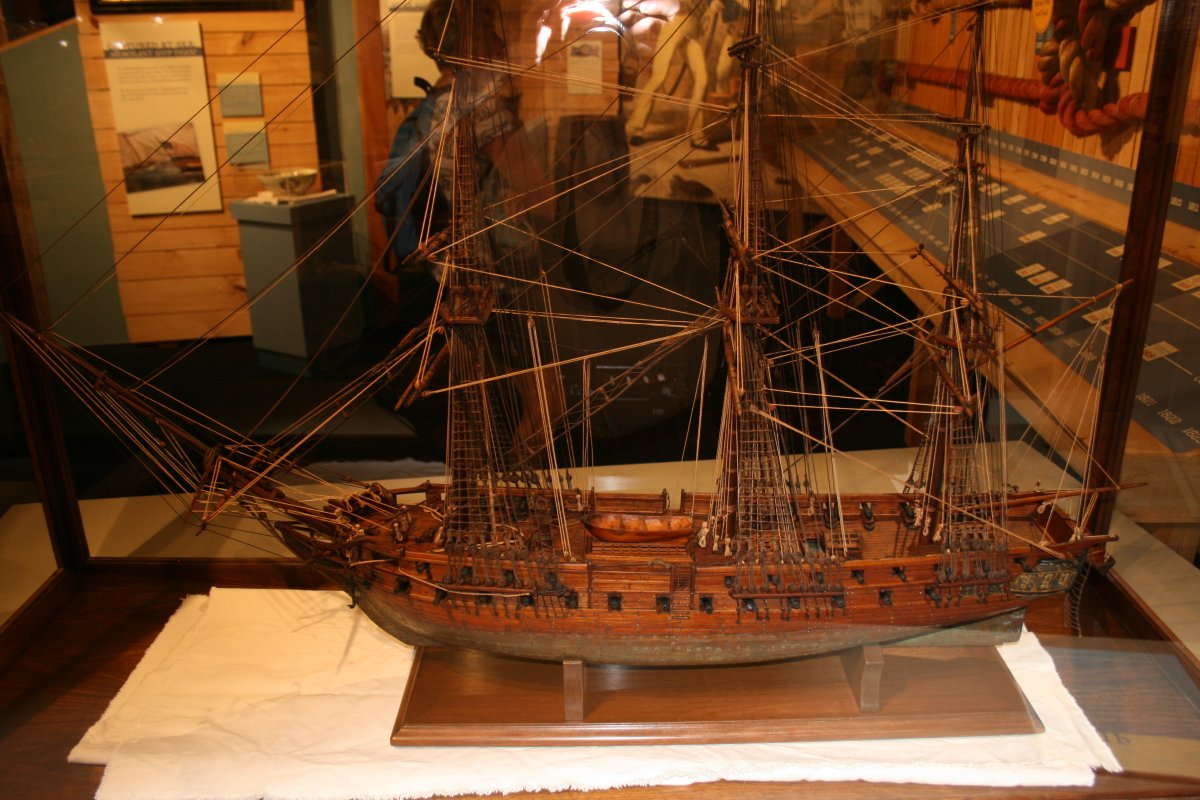 |
|
| America's first Ship of the Line: the USS Pennsylvania. USS Pennsylvania was a three-decked ship of the line of the United States Navy, rated at 130 guns. She was the largest United States sailing warship ever built, the equivalent of a first-rate of the British Royal Navy. Authorized in 1816 and launched in 1837, her only cruise was a single trip from Delaware Baythrough Chesapeake Bay to the Norfolk Navy Yard. The ship became a receiving ship, and during the Civil War was destroyed. |
| |
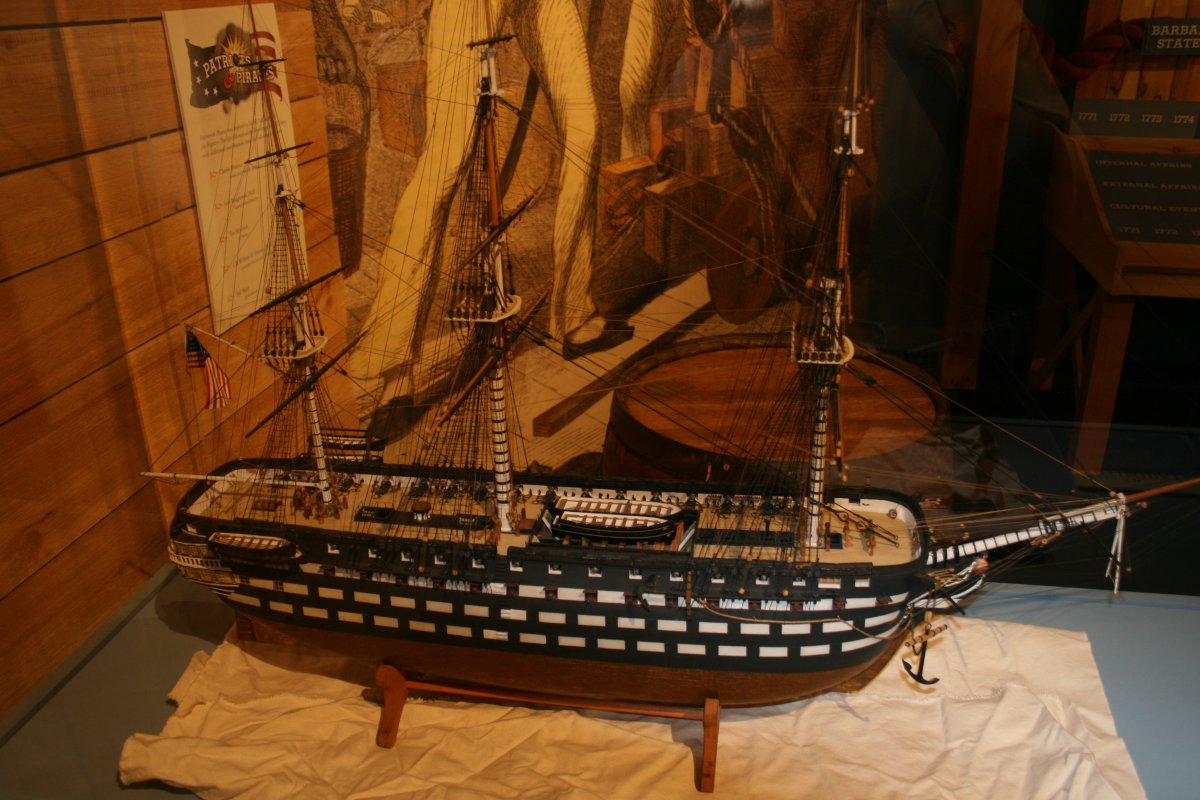 |
|
| Now that is a serious rivet gun and bucking bar! |
| |
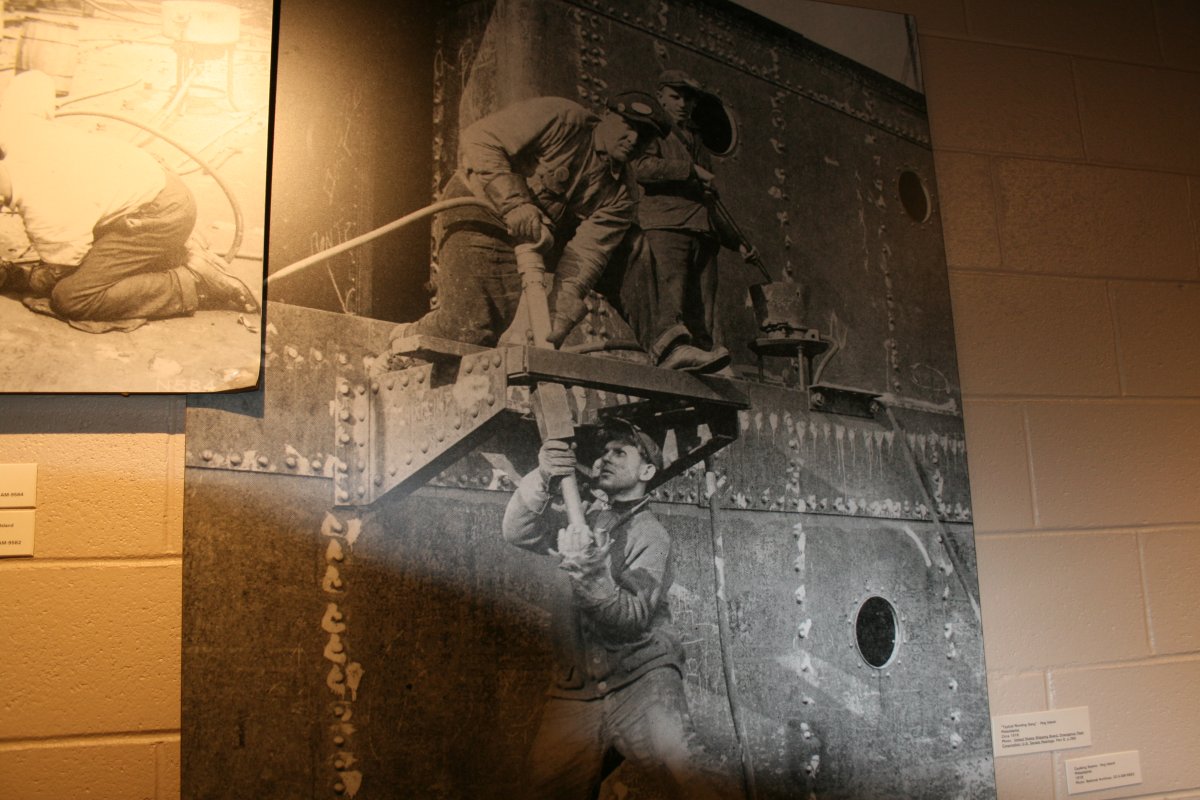 |
|
| |
| |
|
|
|
|
|
|






























































